Literature Review Summary Table Analysis
VerifiedAdded on 2020/04/01
|23
|3777
|84
AI Summary
This assignment requires you to analyze a provided literature review summary table. The table presents various strategies for promoting physical activity, each rated on factors like quality, consistency of findings, and applicability. Your task is to examine the table, evaluate the effectiveness and relevance of different strategies based on the given ratings, and draw conclusions about their potential impact.
Contribute Materials
Your contribution can guide someone’s learning journey. Share your
documents today.
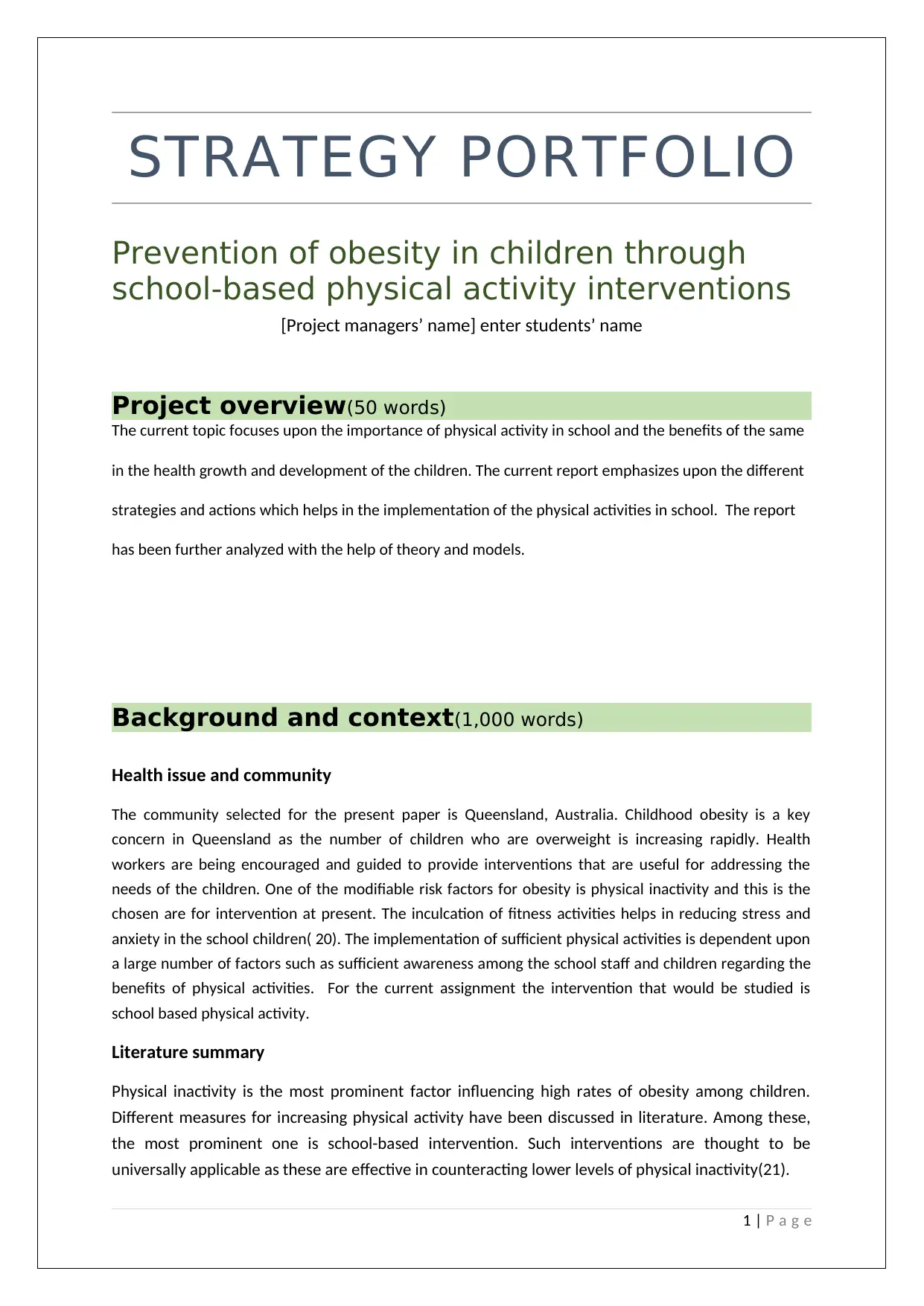
STRATEGY PORTFOLIO
Prevention of obesity in children through
school-based physical activity interventions
[Project managers’ name] enter students’ name
Project overview(50 words)
The current topic focuses upon the importance of physical activity in school and the benefits of the same
in the health growth and development of the children. The current report emphasizes upon the different
strategies and actions which helps in the implementation of the physical activities in school. The report
has been further analyzed with the help of theory and models.
Background and context(1,000 words)
Health issue and community
The community selected for the present paper is Queensland, Australia. Childhood obesity is a key
concern in Queensland as the number of children who are overweight is increasing rapidly. Health
workers are being encouraged and guided to provide interventions that are useful for addressing the
needs of the children. One of the modifiable risk factors for obesity is physical inactivity and this is the
chosen are for intervention at present. The inculcation of fitness activities helps in reducing stress and
anxiety in the school children( 20). The implementation of sufficient physical activities is dependent upon
a large number of factors such as sufficient awareness among the school staff and children regarding the
benefits of physical activities. For the current assignment the intervention that would be studied is
school based physical activity.
Literature summary
Physical inactivity is the most prominent factor influencing high rates of obesity among children.
Different measures for increasing physical activity have been discussed in literature. Among these,
the most prominent one is school-based intervention. Such interventions are thought to be
universally applicable as these are effective in counteracting lower levels of physical inactivity(21).
1 | P a g e
Prevention of obesity in children through
school-based physical activity interventions
[Project managers’ name] enter students’ name
Project overview(50 words)
The current topic focuses upon the importance of physical activity in school and the benefits of the same
in the health growth and development of the children. The current report emphasizes upon the different
strategies and actions which helps in the implementation of the physical activities in school. The report
has been further analyzed with the help of theory and models.
Background and context(1,000 words)
Health issue and community
The community selected for the present paper is Queensland, Australia. Childhood obesity is a key
concern in Queensland as the number of children who are overweight is increasing rapidly. Health
workers are being encouraged and guided to provide interventions that are useful for addressing the
needs of the children. One of the modifiable risk factors for obesity is physical inactivity and this is the
chosen are for intervention at present. The inculcation of fitness activities helps in reducing stress and
anxiety in the school children( 20). The implementation of sufficient physical activities is dependent upon
a large number of factors such as sufficient awareness among the school staff and children regarding the
benefits of physical activities. For the current assignment the intervention that would be studied is
school based physical activity.
Literature summary
Physical inactivity is the most prominent factor influencing high rates of obesity among children.
Different measures for increasing physical activity have been discussed in literature. Among these,
the most prominent one is school-based intervention. Such interventions are thought to be
universally applicable as these are effective in counteracting lower levels of physical inactivity(21).
1 | P a g e
Secure Best Marks with AI Grader
Need help grading? Try our AI Grader for instant feedback on your assignments.
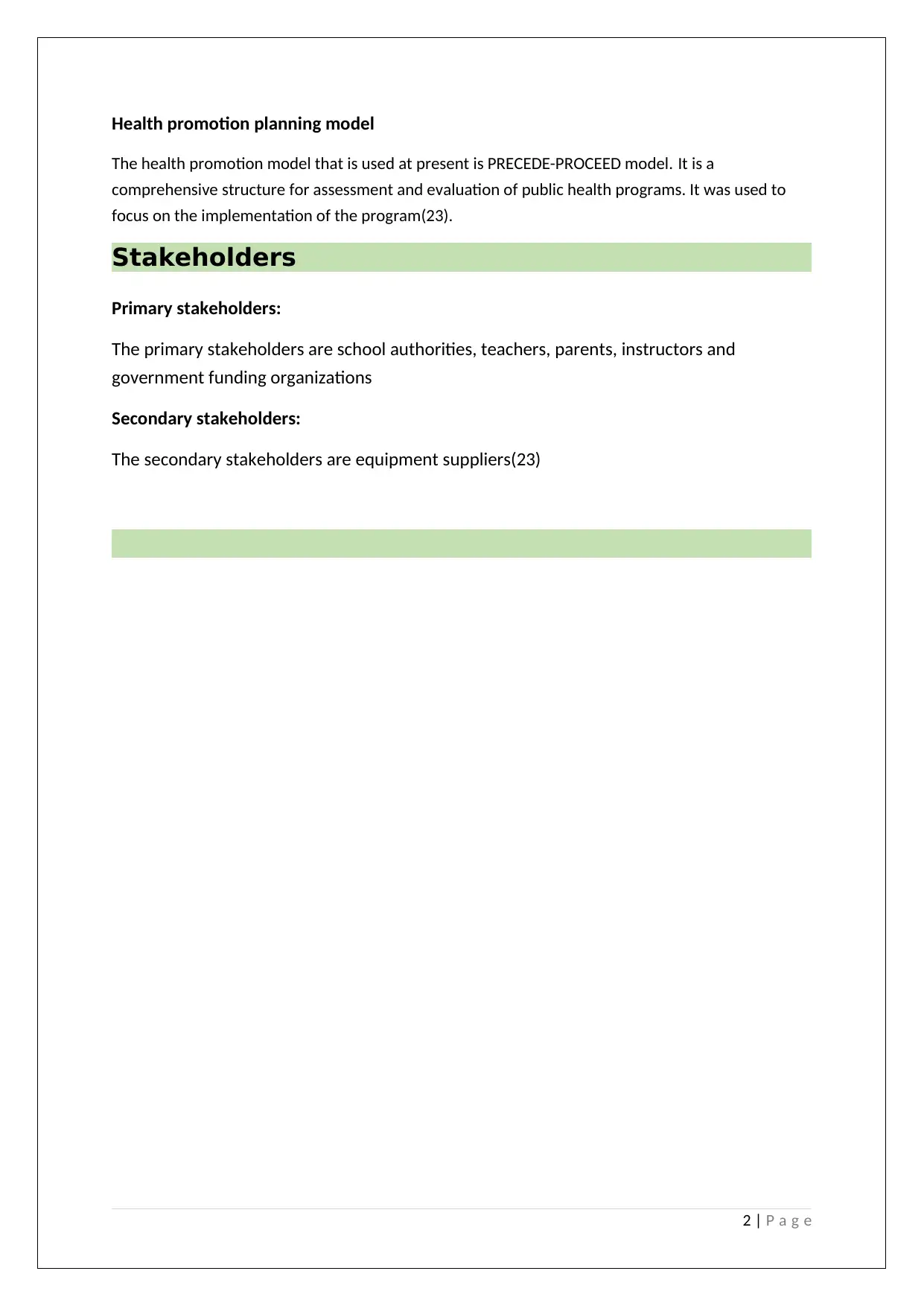
Health promotion planning model
The health promotion model that is used at present is PRECEDE-PROCEED model. It is a
comprehensive structure for assessment and evaluation of public health programs. It was used to
focus on the implementation of the program(23).
Stakeholders
Primary stakeholders:
The primary stakeholders are school authorities, teachers, parents, instructors and
government funding organizations
Secondary stakeholders:
The secondary stakeholders are equipment suppliers(23)
2 | P a g e
The health promotion model that is used at present is PRECEDE-PROCEED model. It is a
comprehensive structure for assessment and evaluation of public health programs. It was used to
focus on the implementation of the program(23).
Stakeholders
Primary stakeholders:
The primary stakeholders are school authorities, teachers, parents, instructors and
government funding organizations
Secondary stakeholders:
The secondary stakeholders are equipment suppliers(23)
2 | P a g e
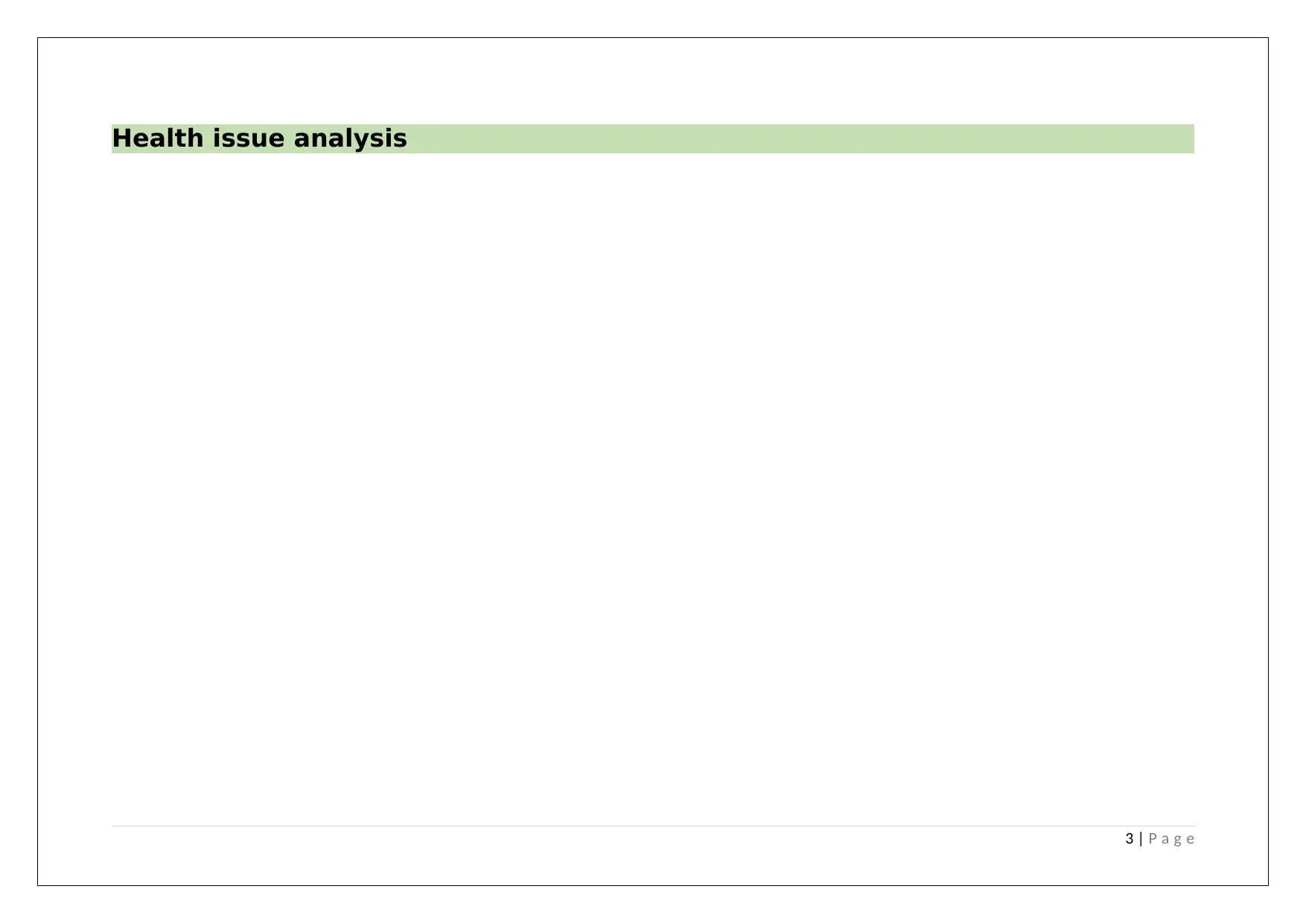
Health issue analysis
3 | P a g e
Highlevelsofinsufficientphysicalactivityamongstudentsatschool1.Lackofenjoymentinparticiptinginphysicalactivity1.1Insufficientfundamentalmovementskills1.2Lackofalternativephysicalactivityoptionsavailable4.Lackofstructuredphysicalactivityprogramsafterschool4.2Lackofphysicalactivitypolicyinafterschoolprogram4.1Lackofrelationshipswithlocalclubs3.Lackofequipment/structurestoencouragephysicalactivityduringbreaks3.2Lackofteachersupervisionofstructuredphsyicalactivity3.1Lackoffundingforequipment2.Insufficientphysicalactivityintheschoolcurriculum2.1Inadequatetrainingofclassroomteacherstodeliverphysicaleducation2.2LackofphysicalactivityschoolpolicyinschoolAt-riskpopuluationsGirlsOlderageLowSESRural
3 | P a g e
Highlevelsofinsufficientphysicalactivityamongstudentsatschool1.Lackofenjoymentinparticiptinginphysicalactivity1.1Insufficientfundamentalmovementskills1.2Lackofalternativephysicalactivityoptionsavailable4.Lackofstructuredphysicalactivityprogramsafterschool4.2Lackofphysicalactivitypolicyinafterschoolprogram4.1Lackofrelationshipswithlocalclubs3.Lackofequipment/structurestoencouragephysicalactivityduringbreaks3.2Lackofteachersupervisionofstructuredphsyicalactivity3.1Lackoffundingforequipment2.Insufficientphysicalactivityintheschoolcurriculum2.1Inadequatetrainingofclassroomteacherstodeliverphysicaleducation2.2LackofphysicalactivityschoolpolicyinschoolAt-riskpopuluationsGirlsOlderageLowSESRural
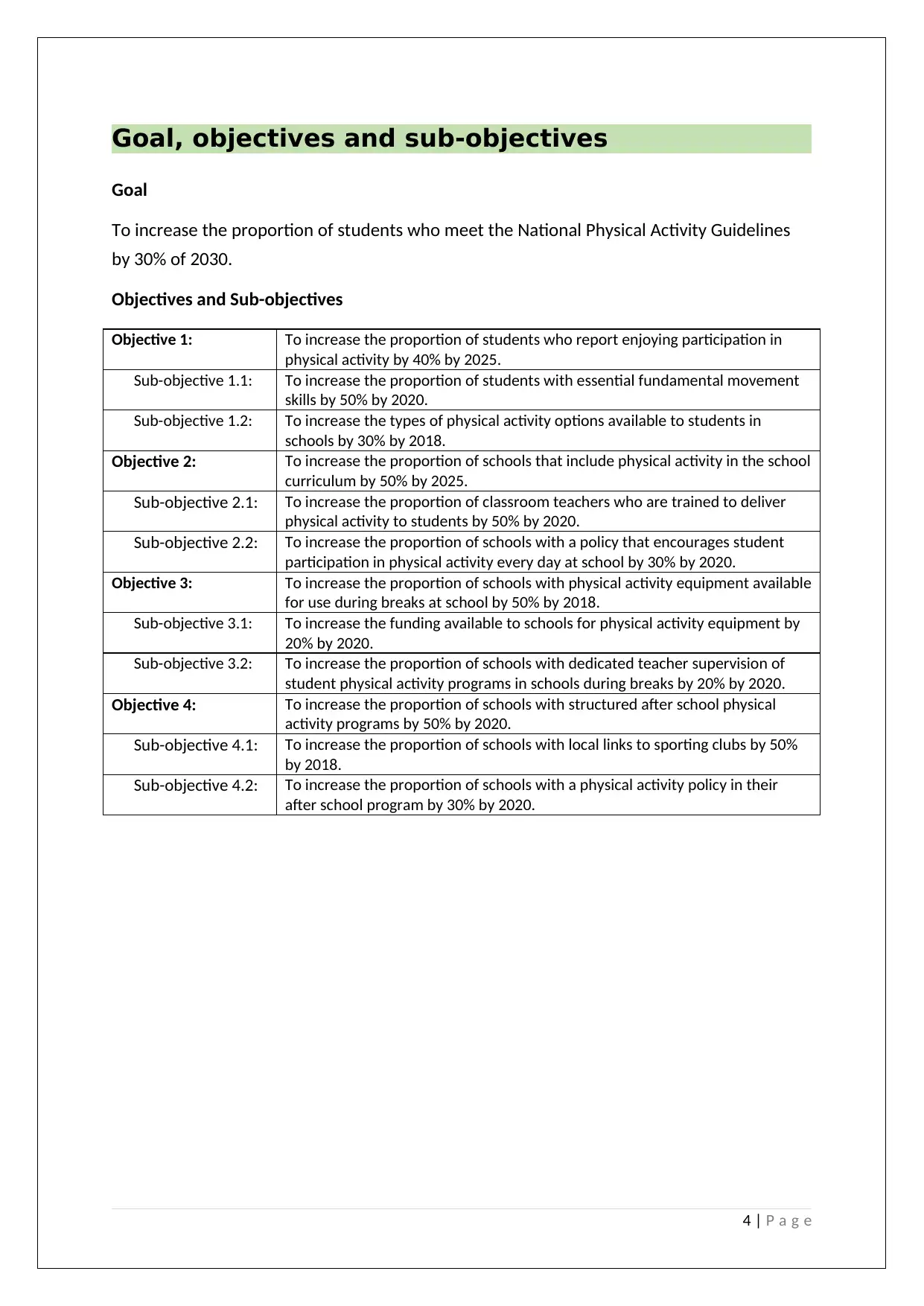
Goal, objectives and sub-objectives
Goal
To increase the proportion of students who meet the National Physical Activity Guidelines
by 30% of 2030.
Objectives and Sub-objectives
Objective 1: To increase the proportion of students who report enjoying participation in
physical activity by 40% by 2025.
Sub-objective 1.1: To increase the proportion of students with essential fundamental movement
skills by 50% by 2020.
Sub-objective 1.2: To increase the types of physical activity options available to students in
schools by 30% by 2018.
Objective 2: To increase the proportion of schools that include physical activity in the school
curriculum by 50% by 2025.
Sub-objective 2.1: To increase the proportion of classroom teachers who are trained to deliver
physical activity to students by 50% by 2020.
Sub-objective 2.2: To increase the proportion of schools with a policy that encourages student
participation in physical activity every day at school by 30% by 2020.
Objective 3: To increase the proportion of schools with physical activity equipment available
for use during breaks at school by 50% by 2018.
Sub-objective 3.1: To increase the funding available to schools for physical activity equipment by
20% by 2020.
Sub-objective 3.2: To increase the proportion of schools with dedicated teacher supervision of
student physical activity programs in schools during breaks by 20% by 2020.
Objective 4: To increase the proportion of schools with structured after school physical
activity programs by 50% by 2020.
Sub-objective 4.1: To increase the proportion of schools with local links to sporting clubs by 50%
by 2018.
Sub-objective 4.2: To increase the proportion of schools with a physical activity policy in their
after school program by 30% by 2020.
4 | P a g e
Goal
To increase the proportion of students who meet the National Physical Activity Guidelines
by 30% of 2030.
Objectives and Sub-objectives
Objective 1: To increase the proportion of students who report enjoying participation in
physical activity by 40% by 2025.
Sub-objective 1.1: To increase the proportion of students with essential fundamental movement
skills by 50% by 2020.
Sub-objective 1.2: To increase the types of physical activity options available to students in
schools by 30% by 2018.
Objective 2: To increase the proportion of schools that include physical activity in the school
curriculum by 50% by 2025.
Sub-objective 2.1: To increase the proportion of classroom teachers who are trained to deliver
physical activity to students by 50% by 2020.
Sub-objective 2.2: To increase the proportion of schools with a policy that encourages student
participation in physical activity every day at school by 30% by 2020.
Objective 3: To increase the proportion of schools with physical activity equipment available
for use during breaks at school by 50% by 2018.
Sub-objective 3.1: To increase the funding available to schools for physical activity equipment by
20% by 2020.
Sub-objective 3.2: To increase the proportion of schools with dedicated teacher supervision of
student physical activity programs in schools during breaks by 20% by 2020.
Objective 4: To increase the proportion of schools with structured after school physical
activity programs by 50% by 2020.
Sub-objective 4.1: To increase the proportion of schools with local links to sporting clubs by 50%
by 2018.
Sub-objective 4.2: To increase the proportion of schools with a physical activity policy in their
after school program by 30% by 2020.
4 | P a g e
Secure Best Marks with AI Grader
Need help grading? Try our AI Grader for instant feedback on your assignments.

Strategy portfolio
Strategy
Ottawa Charter Action Areas Determinants
Guiding
Theory/ies/
Model/s
Develop personal
skills
Strengthen
community action
Reorient health
services
Create supportive
environments
Healthy public
policy
1: adequate
playground area
2: adequate
knowledge on
benefits of physical
activity
3 : motivation to
carry out physical
activity
4: support from
parents
5:
6:
1: Creating optimal environment at recess Behaviour
change
2: Health related education program Communication
change
3: Physical education program Communication
change
4: Provide intrinsic motivation and
understand emotions behind play
Behaviour
change
5: [insert strategy]
[Add more columns and rows if needed.]
5 | P a g e
Strategy
Ottawa Charter Action Areas Determinants
Guiding
Theory/ies/
Model/s
Develop personal
skills
Strengthen
community action
Reorient health
services
Create supportive
environments
Healthy public
policy
1: adequate
playground area
2: adequate
knowledge on
benefits of physical
activity
3 : motivation to
carry out physical
activity
4: support from
parents
5:
6:
1: Creating optimal environment at recess Behaviour
change
2: Health related education program Communication
change
3: Physical education program Communication
change
4: Provide intrinsic motivation and
understand emotions behind play
Behaviour
change
5: [insert strategy]
[Add more columns and rows if needed.]
5 | P a g e
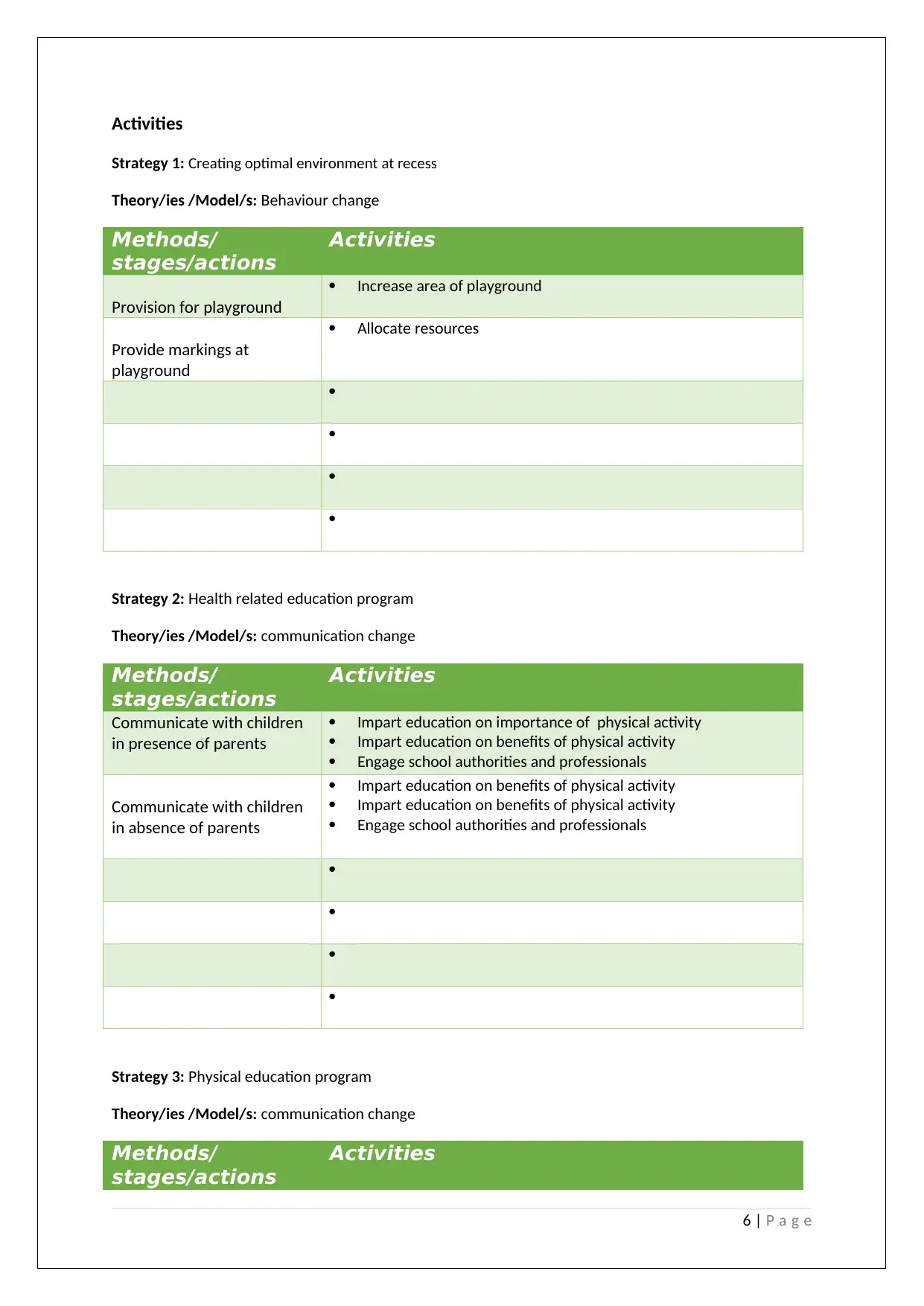
Activities
Strategy 1: Creating optimal environment at recess
Theory/ies /Model/s: Behaviour change
Methods/
stages/actions
Activities
Provision for playground
Increase area of playground
Provide markings at
playground
Allocate resources
Strategy 2: Health related education program
Theory/ies /Model/s: communication change
Methods/
stages/actions
Activities
Communicate with children
in presence of parents
Impart education on importance of physical activity
Impart education on benefits of physical activity
Engage school authorities and professionals
Communicate with children
in absence of parents
Impart education on benefits of physical activity
Impart education on benefits of physical activity
Engage school authorities and professionals
Strategy 3: Physical education program
Theory/ies /Model/s: communication change
Methods/
stages/actions
Activities
6 | P a g e
Strategy 1: Creating optimal environment at recess
Theory/ies /Model/s: Behaviour change
Methods/
stages/actions
Activities
Provision for playground
Increase area of playground
Provide markings at
playground
Allocate resources
Strategy 2: Health related education program
Theory/ies /Model/s: communication change
Methods/
stages/actions
Activities
Communicate with children
in presence of parents
Impart education on importance of physical activity
Impart education on benefits of physical activity
Engage school authorities and professionals
Communicate with children
in absence of parents
Impart education on benefits of physical activity
Impart education on benefits of physical activity
Engage school authorities and professionals
Strategy 3: Physical education program
Theory/ies /Model/s: communication change
Methods/
stages/actions
Activities
6 | P a g e
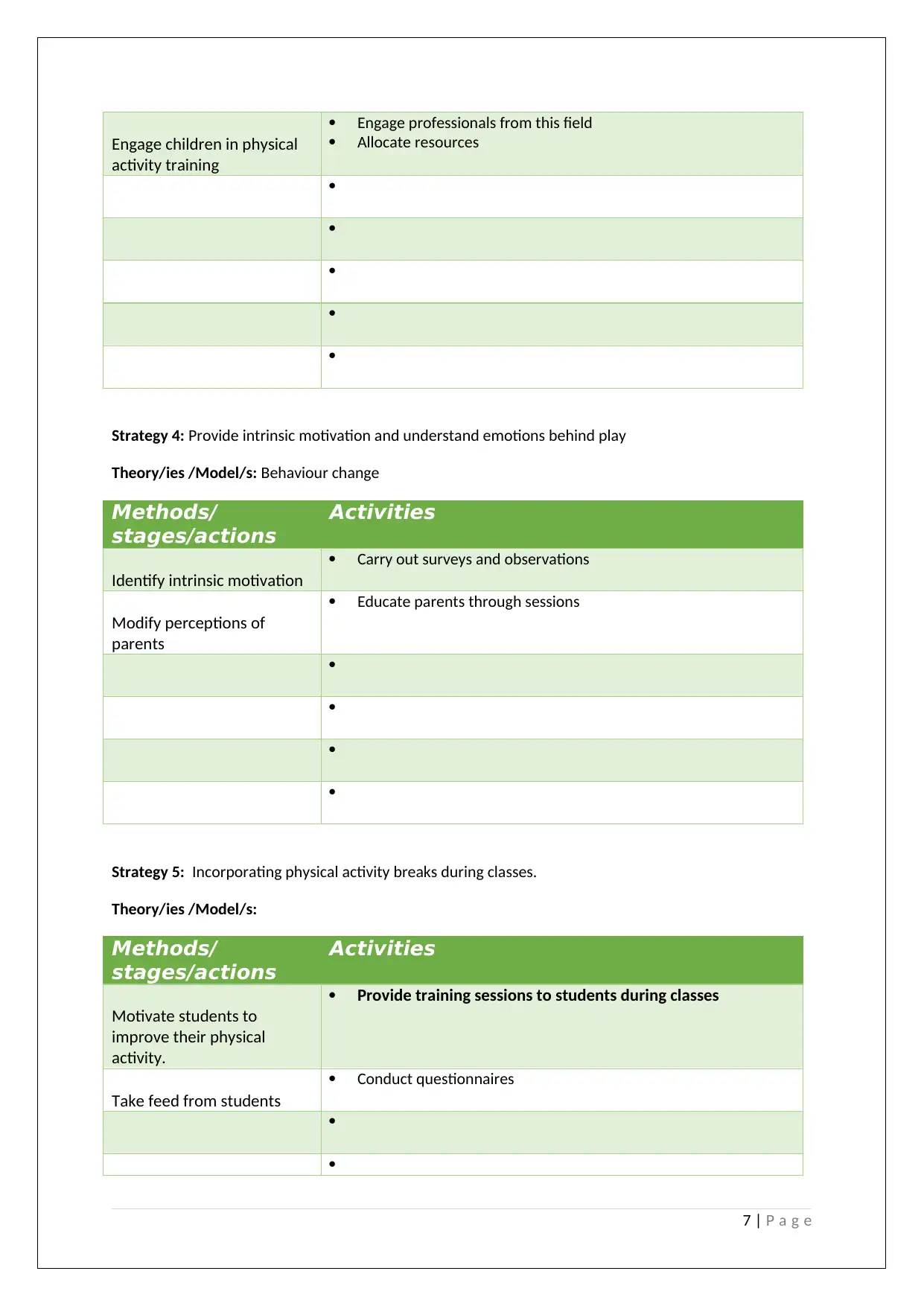
Engage children in physical
activity training
Engage professionals from this field
Allocate resources
Strategy 4: Provide intrinsic motivation and understand emotions behind play
Theory/ies /Model/s: Behaviour change
Methods/
stages/actions
Activities
Identify intrinsic motivation
Carry out surveys and observations
Modify perceptions of
parents
Educate parents through sessions
Strategy 5: Incorporating physical activity breaks during classes.
Theory/ies /Model/s:
Methods/
stages/actions
Activities
Motivate students to
improve their physical
activity.
Provide training sessions to students during classes
Take feed from students
Conduct questionnaires
7 | P a g e
activity training
Engage professionals from this field
Allocate resources
Strategy 4: Provide intrinsic motivation and understand emotions behind play
Theory/ies /Model/s: Behaviour change
Methods/
stages/actions
Activities
Identify intrinsic motivation
Carry out surveys and observations
Modify perceptions of
parents
Educate parents through sessions
Strategy 5: Incorporating physical activity breaks during classes.
Theory/ies /Model/s:
Methods/
stages/actions
Activities
Motivate students to
improve their physical
activity.
Provide training sessions to students during classes
Take feed from students
Conduct questionnaires
7 | P a g e
Paraphrase This Document
Need a fresh take? Get an instant paraphrase of this document with our AI Paraphraser
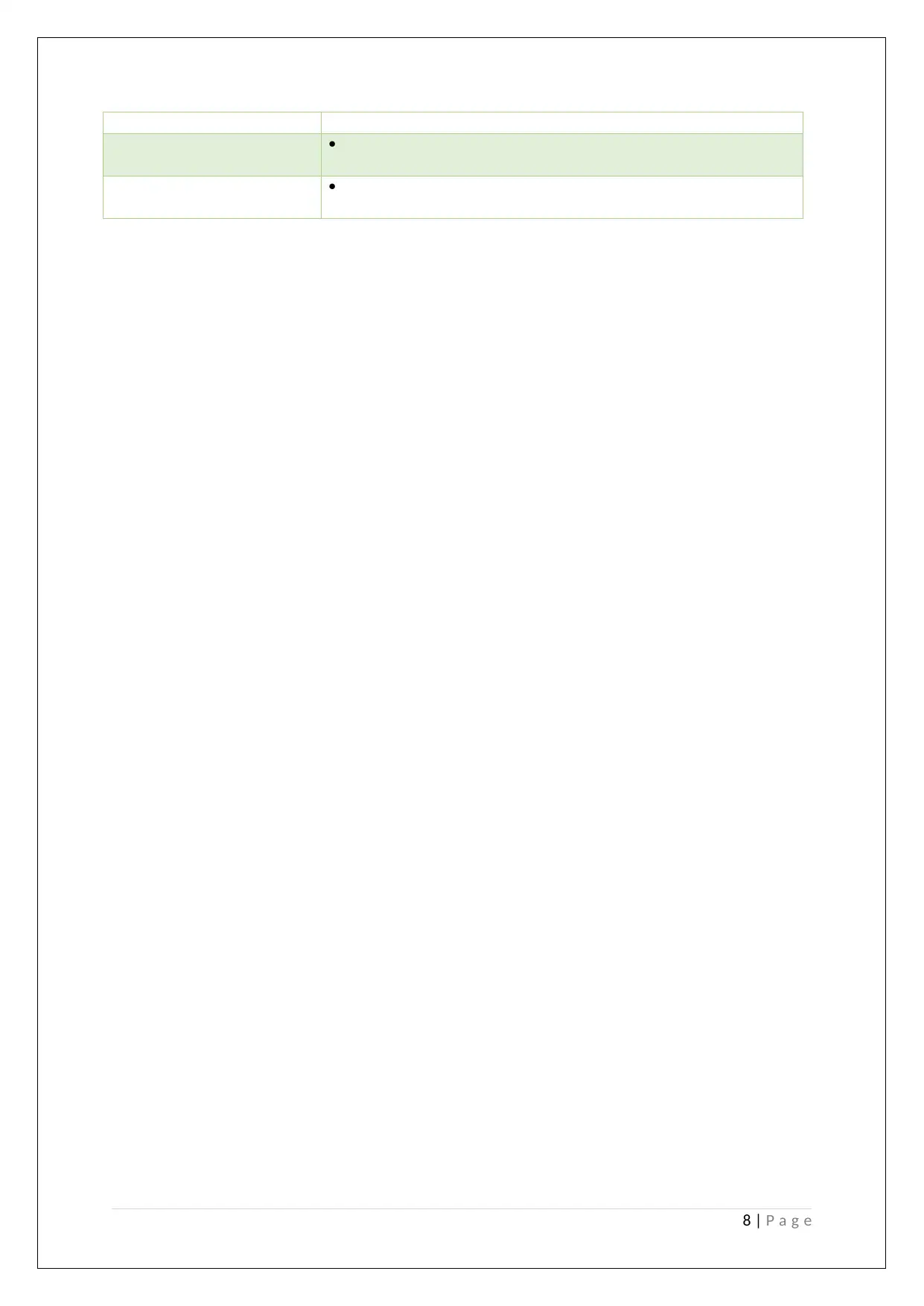
8 | P a g e
8 | P a g e
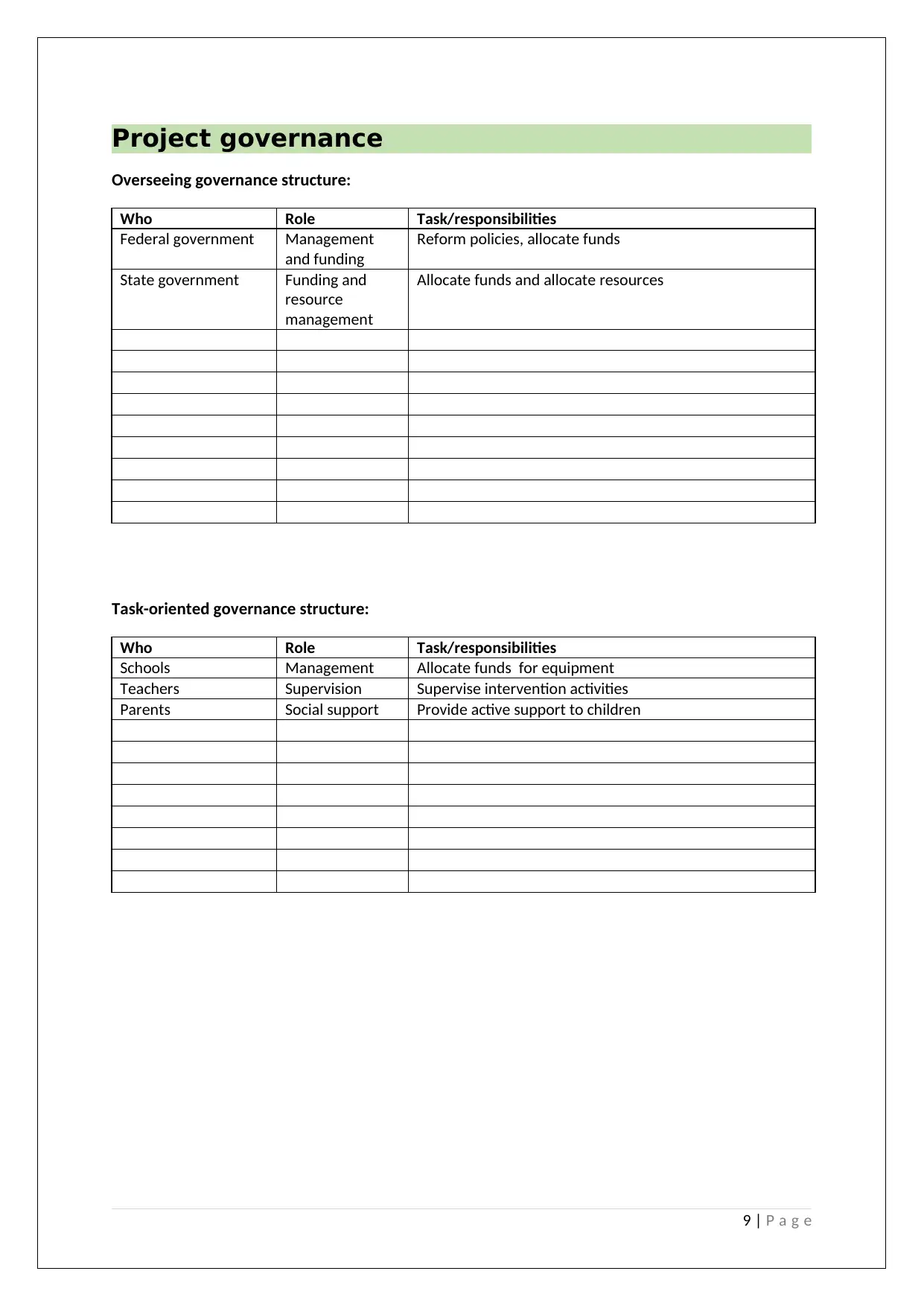
Project governance
Overseeing governance structure:
Who Role Task/responsibilities
Federal government Management
and funding
Reform policies, allocate funds
State government Funding and
resource
management
Allocate funds and allocate resources
Task-oriented governance structure:
Who Role Task/responsibilities
Schools Management Allocate funds for equipment
Teachers Supervision Supervise intervention activities
Parents Social support Provide active support to children
9 | P a g e
Overseeing governance structure:
Who Role Task/responsibilities
Federal government Management
and funding
Reform policies, allocate funds
State government Funding and
resource
management
Allocate funds and allocate resources
Task-oriented governance structure:
Who Role Task/responsibilities
Schools Management Allocate funds for equipment
Teachers Supervision Supervise intervention activities
Parents Social support Provide active support to children
9 | P a g e
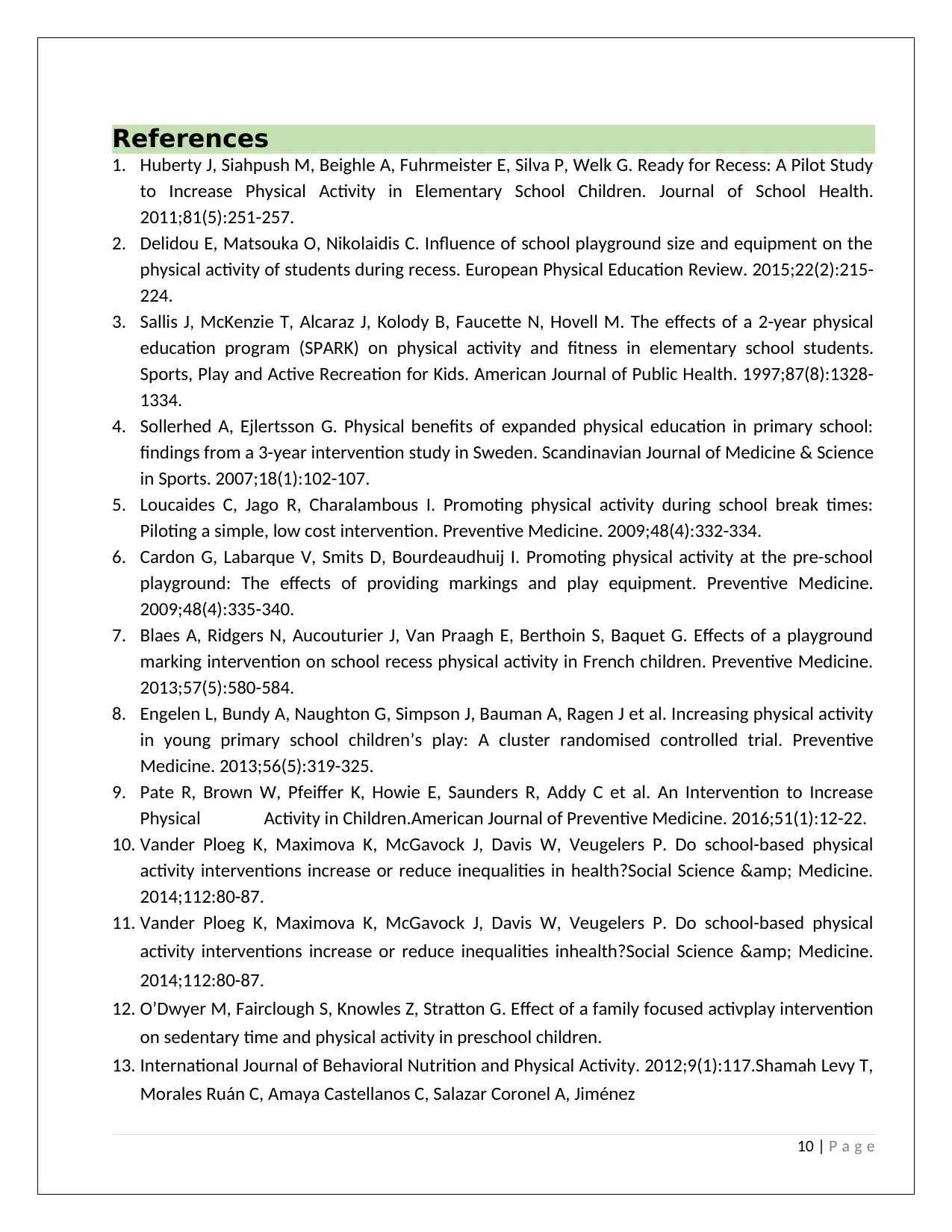
References
1. Huberty J, Siahpush M, Beighle A, Fuhrmeister E, Silva P, Welk G. Ready for Recess: A Pilot Study
to Increase Physical Activity in Elementary School Children. Journal of School Health.
2011;81(5):251-257.
2. Delidou E, Matsouka O, Nikolaidis C. Influence of school playground size and equipment on the
physical activity of students during recess. European Physical Education Review. 2015;22(2):215-
224.
3. Sallis J, McKenzie T, Alcaraz J, Kolody B, Faucette N, Hovell M. The effects of a 2-year physical
education program (SPARK) on physical activity and fitness in elementary school students.
Sports, Play and Active Recreation for Kids. American Journal of Public Health. 1997;87(8):1328-
1334.
4. Sollerhed A, Ejlertsson G. Physical benefits of expanded physical education in primary school:
findings from a 3-year intervention study in Sweden. Scandinavian Journal of Medicine & Science
in Sports. 2007;18(1):102-107.
5. Loucaides C, Jago R, Charalambous I. Promoting physical activity during school break times:
Piloting a simple, low cost intervention. Preventive Medicine. 2009;48(4):332-334.
6. Cardon G, Labarque V, Smits D, Bourdeaudhuij I. Promoting physical activity at the pre-school
playground: The effects of providing markings and play equipment. Preventive Medicine.
2009;48(4):335-340.
7. Blaes A, Ridgers N, Aucouturier J, Van Praagh E, Berthoin S, Baquet G. Effects of a playground
marking intervention on school recess physical activity in French children. Preventive Medicine.
2013;57(5):580-584.
8. Engelen L, Bundy A, Naughton G, Simpson J, Bauman A, Ragen J et al. Increasing physical activity
in young primary school children’s play: A cluster randomised controlled trial. Preventive
Medicine. 2013;56(5):319-325.
9. Pate R, Brown W, Pfeiffer K, Howie E, Saunders R, Addy C et al. An Intervention to Increase
Physical Activity in Children.American Journal of Preventive Medicine. 2016;51(1):12-22.
10. Vander Ploeg K, Maximova K, McGavock J, Davis W, Veugelers P. Do school-based physical
activity interventions increase or reduce inequalities in health?Social Science & Medicine.
2014;112:80-87.
11. Vander Ploeg K, Maximova K, McGavock J, Davis W, Veugelers P. Do school-based physical
activity interventions increase or reduce inequalities inhealth?Social Science & Medicine.
2014;112:80-87.
12. O’Dwyer M, Fairclough S, Knowles Z, Stratton G. Effect of a family focused activplay intervention
on sedentary time and physical activity in preschool children.
13. International Journal of Behavioral Nutrition and Physical Activity. 2012;9(1):117.Shamah Levy T,
Morales Ruán C, Amaya Castellanos C, Salazar Coronel A, Jiménez
10 | P a g e
1. Huberty J, Siahpush M, Beighle A, Fuhrmeister E, Silva P, Welk G. Ready for Recess: A Pilot Study
to Increase Physical Activity in Elementary School Children. Journal of School Health.
2011;81(5):251-257.
2. Delidou E, Matsouka O, Nikolaidis C. Influence of school playground size and equipment on the
physical activity of students during recess. European Physical Education Review. 2015;22(2):215-
224.
3. Sallis J, McKenzie T, Alcaraz J, Kolody B, Faucette N, Hovell M. The effects of a 2-year physical
education program (SPARK) on physical activity and fitness in elementary school students.
Sports, Play and Active Recreation for Kids. American Journal of Public Health. 1997;87(8):1328-
1334.
4. Sollerhed A, Ejlertsson G. Physical benefits of expanded physical education in primary school:
findings from a 3-year intervention study in Sweden. Scandinavian Journal of Medicine & Science
in Sports. 2007;18(1):102-107.
5. Loucaides C, Jago R, Charalambous I. Promoting physical activity during school break times:
Piloting a simple, low cost intervention. Preventive Medicine. 2009;48(4):332-334.
6. Cardon G, Labarque V, Smits D, Bourdeaudhuij I. Promoting physical activity at the pre-school
playground: The effects of providing markings and play equipment. Preventive Medicine.
2009;48(4):335-340.
7. Blaes A, Ridgers N, Aucouturier J, Van Praagh E, Berthoin S, Baquet G. Effects of a playground
marking intervention on school recess physical activity in French children. Preventive Medicine.
2013;57(5):580-584.
8. Engelen L, Bundy A, Naughton G, Simpson J, Bauman A, Ragen J et al. Increasing physical activity
in young primary school children’s play: A cluster randomised controlled trial. Preventive
Medicine. 2013;56(5):319-325.
9. Pate R, Brown W, Pfeiffer K, Howie E, Saunders R, Addy C et al. An Intervention to Increase
Physical Activity in Children.American Journal of Preventive Medicine. 2016;51(1):12-22.
10. Vander Ploeg K, Maximova K, McGavock J, Davis W, Veugelers P. Do school-based physical
activity interventions increase or reduce inequalities in health?Social Science & Medicine.
2014;112:80-87.
11. Vander Ploeg K, Maximova K, McGavock J, Davis W, Veugelers P. Do school-based physical
activity interventions increase or reduce inequalities inhealth?Social Science & Medicine.
2014;112:80-87.
12. O’Dwyer M, Fairclough S, Knowles Z, Stratton G. Effect of a family focused activplay intervention
on sedentary time and physical activity in preschool children.
13. International Journal of Behavioral Nutrition and Physical Activity. 2012;9(1):117.Shamah Levy T,
Morales Ruán C, Amaya Castellanos C, Salazar Coronel A, Jiménez
10 | P a g e
Secure Best Marks with AI Grader
Need help grading? Try our AI Grader for instant feedback on your assignments.

14. Aguilar A, Méndez Gómez Humarán I. Effectiveness of a diet and physical activity promotion
strategy on the prevention of obesity in Mexican school children. BMC Public Health. 2012;12(1).
15. Kriemler S, Zahner L, Schindler C, Meyer U, Hartmann T, Hebestreit H et al. Effect of school
based physical activity programme (KISS) on fitness and adiposity in primary schoolchildren:
cluster randomised controlled trial. BMJ. 2010;340(feb23 1):c785-c785.
16. Larson T, Normand M, Morley A, Hustyi K. The Role of the Physical Environment in Promoting
Physical Activity in Children Across Different Group Compositions. Behavior Modification.
2014;38(6):837-851.
17. Wadsworth D, Robinson L, Beckham K, Webster K. Break for Physical Activity: Incorporating
Classroom-Based Physical Activity Breaks into Preschools. Early Childhood Education Journal.
2011;39(6):391-395.
18. Berg S. Children’s Activity Levels in Different Playground Environments: An Observational Study
in Four Canadian Preschools. Early Childhood Education Journal. 2014;43(4):281-287.
19. Erwin H, Beighle A, Morgan C, Noland M. Effect of a Low-Cost, Teacher-Directed Classroom
Intervention on Elementary Students' Physical Activity. Journal of School Health. 2011;81(8):455-
461.
20. Zahner L, Puder J, Roth R, Schmid M, Guldimann R, Pühse U et al. A school-based physical
activity program to improve health and fitness in children aged 6–13 years("Kinder-
Sportstudie KISS"): study design of a randomized controlled trial[ISRCTN15360785]. BMC
Public Health. 2006;6(1).
21. Mihrshahi S, Vaughan L, Fa’avale N, Weliange SD, Manu-Sione I, Schubert L. Evaluation of the Good
Start Program: a healthy eating and physical activity intervention for Maori and Pacific Islander children
living in Queensland, Australia. BMC public health. 2017 Jan 13;17(1):77.
22. Miura K, Ballard E, Clemens SL, Harper CM, Begum N, O'Rourke PK, Green AC. Sex-specific
associations with youth obesity in Queensland, Australia. Public Health. 2017 Apr 30;145:146-
8.
23. Fatima Y, Mamun AA. Longitudinal impact of sleep on overweight and obesity in children and
adolescents: a systematic review and bias‐adjusted meta‐analysis. Obesity Reviews. 2015
Feb 1;16(2):137-49.
11 | P a g e
strategy on the prevention of obesity in Mexican school children. BMC Public Health. 2012;12(1).
15. Kriemler S, Zahner L, Schindler C, Meyer U, Hartmann T, Hebestreit H et al. Effect of school
based physical activity programme (KISS) on fitness and adiposity in primary schoolchildren:
cluster randomised controlled trial. BMJ. 2010;340(feb23 1):c785-c785.
16. Larson T, Normand M, Morley A, Hustyi K. The Role of the Physical Environment in Promoting
Physical Activity in Children Across Different Group Compositions. Behavior Modification.
2014;38(6):837-851.
17. Wadsworth D, Robinson L, Beckham K, Webster K. Break for Physical Activity: Incorporating
Classroom-Based Physical Activity Breaks into Preschools. Early Childhood Education Journal.
2011;39(6):391-395.
18. Berg S. Children’s Activity Levels in Different Playground Environments: An Observational Study
in Four Canadian Preschools. Early Childhood Education Journal. 2014;43(4):281-287.
19. Erwin H, Beighle A, Morgan C, Noland M. Effect of a Low-Cost, Teacher-Directed Classroom
Intervention on Elementary Students' Physical Activity. Journal of School Health. 2011;81(8):455-
461.
20. Zahner L, Puder J, Roth R, Schmid M, Guldimann R, Pühse U et al. A school-based physical
activity program to improve health and fitness in children aged 6–13 years("Kinder-
Sportstudie KISS"): study design of a randomized controlled trial[ISRCTN15360785]. BMC
Public Health. 2006;6(1).
21. Mihrshahi S, Vaughan L, Fa’avale N, Weliange SD, Manu-Sione I, Schubert L. Evaluation of the Good
Start Program: a healthy eating and physical activity intervention for Maori and Pacific Islander children
living in Queensland, Australia. BMC public health. 2017 Jan 13;17(1):77.
22. Miura K, Ballard E, Clemens SL, Harper CM, Begum N, O'Rourke PK, Green AC. Sex-specific
associations with youth obesity in Queensland, Australia. Public Health. 2017 Apr 30;145:146-
8.
23. Fatima Y, Mamun AA. Longitudinal impact of sleep on overweight and obesity in children and
adolescents: a systematic review and bias‐adjusted meta‐analysis. Obesity Reviews. 2015
Feb 1;16(2):137-49.
11 | P a g e
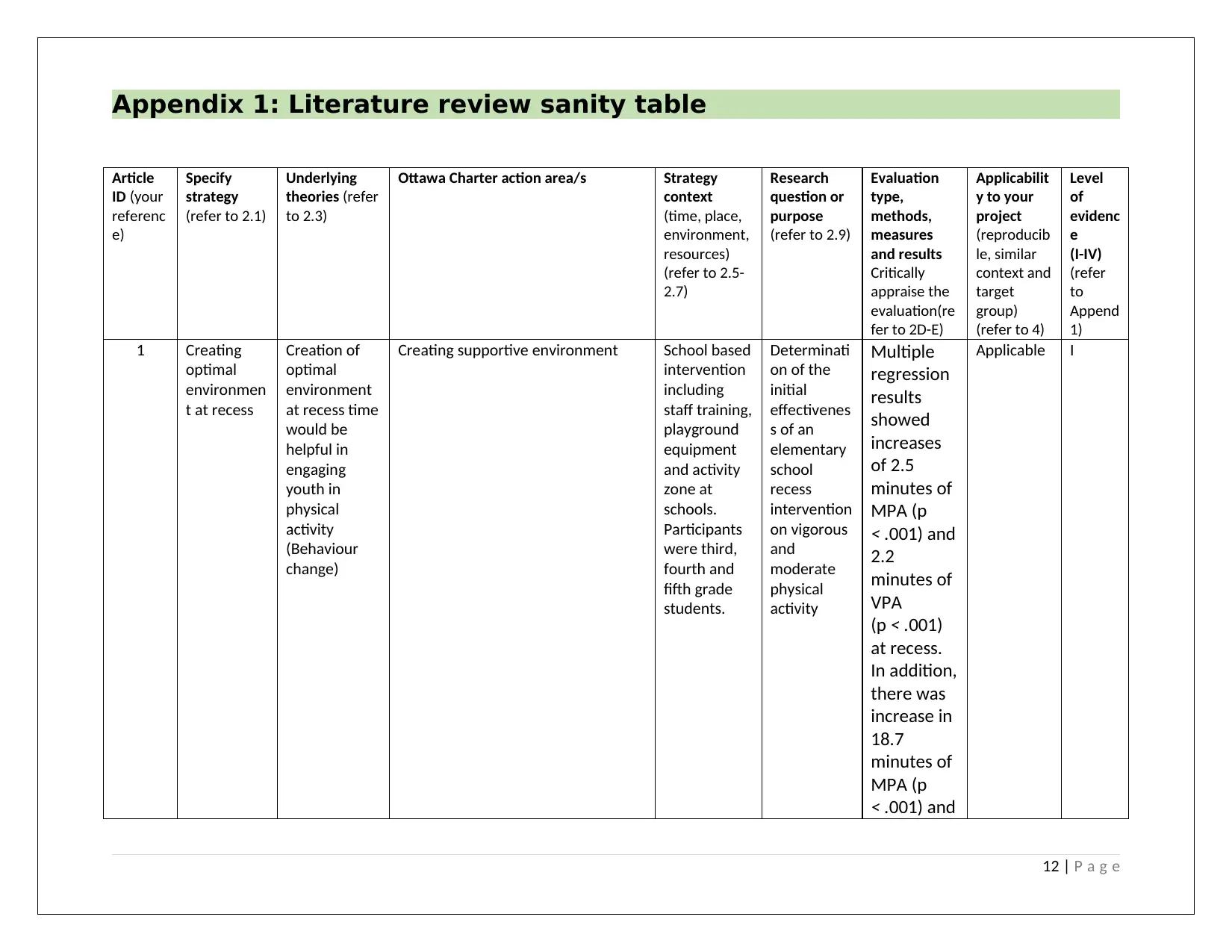
Appendix 1: Literature review sanity table
Article
ID (your
referenc
e)
Specify
strategy
(refer to 2.1)
Underlying
theories (refer
to 2.3)
Ottawa Charter action area/s Strategy
context
(time, place,
environment,
resources)
(refer to 2.5-
2.7)
Research
question or
purpose
(refer to 2.9)
Evaluation
type,
methods,
measures
and results
Critically
appraise the
evaluation(re
fer to 2D-E)
Applicabilit
y to your
project
(reproducib
le, similar
context and
target
group)
(refer to 4)
Level
of
evidenc
e
(I-IV)
(refer
to
Append
1)
1 Creating
optimal
environmen
t at recess
Creation of
optimal
environment
at recess time
would be
helpful in
engaging
youth in
physical
activity
(Behaviour
change)
Creating supportive environment School based
intervention
including
staff training,
playground
equipment
and activity
zone at
schools.
Participants
were third,
fourth and
fifth grade
students.
Determinati
on of the
initial
effectivenes
s of an
elementary
school
recess
intervention
on vigorous
and
moderate
physical
activity
Multiple
regression
results
showed
increases
of 2.5
minutes of
MPA (p
< .001) and
2.2
minutes of
VPA
(p < .001)
at recess.
In addition,
there was
increase in
18.7
minutes of
MPA (p
< .001) and
Applicable I
12 | P a g e
Article
ID (your
referenc
e)
Specify
strategy
(refer to 2.1)
Underlying
theories (refer
to 2.3)
Ottawa Charter action area/s Strategy
context
(time, place,
environment,
resources)
(refer to 2.5-
2.7)
Research
question or
purpose
(refer to 2.9)
Evaluation
type,
methods,
measures
and results
Critically
appraise the
evaluation(re
fer to 2D-E)
Applicabilit
y to your
project
(reproducib
le, similar
context and
target
group)
(refer to 4)
Level
of
evidenc
e
(I-IV)
(refer
to
Append
1)
1 Creating
optimal
environmen
t at recess
Creation of
optimal
environment
at recess time
would be
helpful in
engaging
youth in
physical
activity
(Behaviour
change)
Creating supportive environment School based
intervention
including
staff training,
playground
equipment
and activity
zone at
schools.
Participants
were third,
fourth and
fifth grade
students.
Determinati
on of the
initial
effectivenes
s of an
elementary
school
recess
intervention
on vigorous
and
moderate
physical
activity
Multiple
regression
results
showed
increases
of 2.5
minutes of
MPA (p
< .001) and
2.2
minutes of
VPA
(p < .001)
at recess.
In addition,
there was
increase in
18.7
minutes of
MPA (p
< .001) and
Applicable I
12 | P a g e
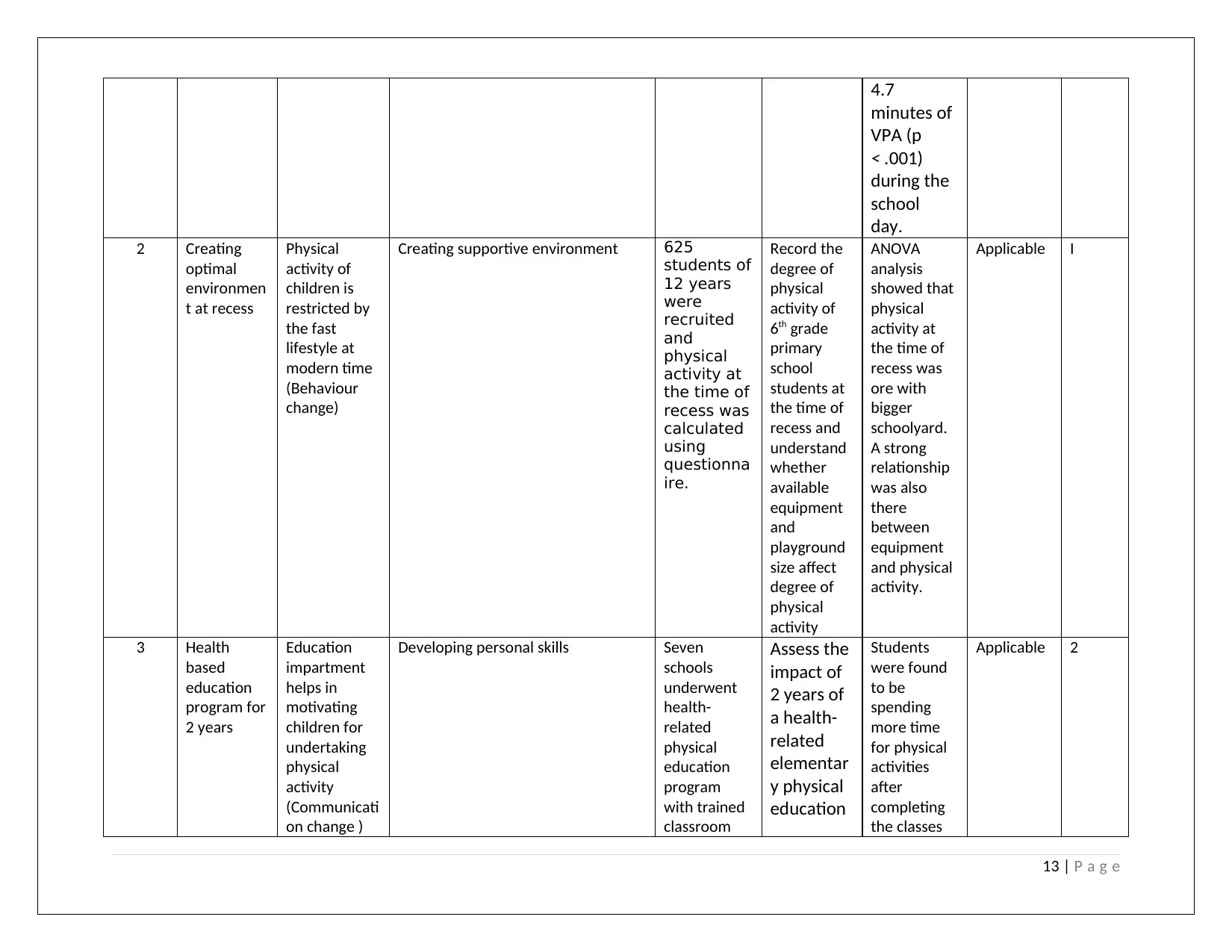
4.7
minutes of
VPA (p
< .001)
during the
school
day.
2 Creating
optimal
environmen
t at recess
Physical
activity of
children is
restricted by
the fast
lifestyle at
modern time
(Behaviour
change)
Creating supportive environment 625
students of
12 years
were
recruited
and
physical
activity at
the time of
recess was
calculated
using
questionna
ire.
Record the
degree of
physical
activity of
6th grade
primary
school
students at
the time of
recess and
understand
whether
available
equipment
and
playground
size affect
degree of
physical
activity
ANOVA
analysis
showed that
physical
activity at
the time of
recess was
ore with
bigger
schoolyard.
A strong
relationship
was also
there
between
equipment
and physical
activity.
Applicable I
3 Health
based
education
program for
2 years
Education
impartment
helps in
motivating
children for
undertaking
physical
activity
(Communicati
on change )
Developing personal skills Seven
schools
underwent
health-
related
physical
education
program
with trained
classroom
Assess the
impact of
2 years of
a health-
related
elementar
y physical
education
Students
were found
to be
spending
more time
for physical
activities
after
completing
the classes
Applicable 2
13 | P a g e
minutes of
VPA (p
< .001)
during the
school
day.
2 Creating
optimal
environmen
t at recess
Physical
activity of
children is
restricted by
the fast
lifestyle at
modern time
(Behaviour
change)
Creating supportive environment 625
students of
12 years
were
recruited
and
physical
activity at
the time of
recess was
calculated
using
questionna
ire.
Record the
degree of
physical
activity of
6th grade
primary
school
students at
the time of
recess and
understand
whether
available
equipment
and
playground
size affect
degree of
physical
activity
ANOVA
analysis
showed that
physical
activity at
the time of
recess was
ore with
bigger
schoolyard.
A strong
relationship
was also
there
between
equipment
and physical
activity.
Applicable I
3 Health
based
education
program for
2 years
Education
impartment
helps in
motivating
children for
undertaking
physical
activity
(Communicati
on change )
Developing personal skills Seven
schools
underwent
health-
related
physical
education
program
with trained
classroom
Assess the
impact of
2 years of
a health-
related
elementar
y physical
education
Students
were found
to be
spending
more time
for physical
activities
after
completing
the classes
Applicable 2
13 | P a g e
Paraphrase This Document
Need a fresh take? Get an instant paraphrase of this document with our AI Paraphraser
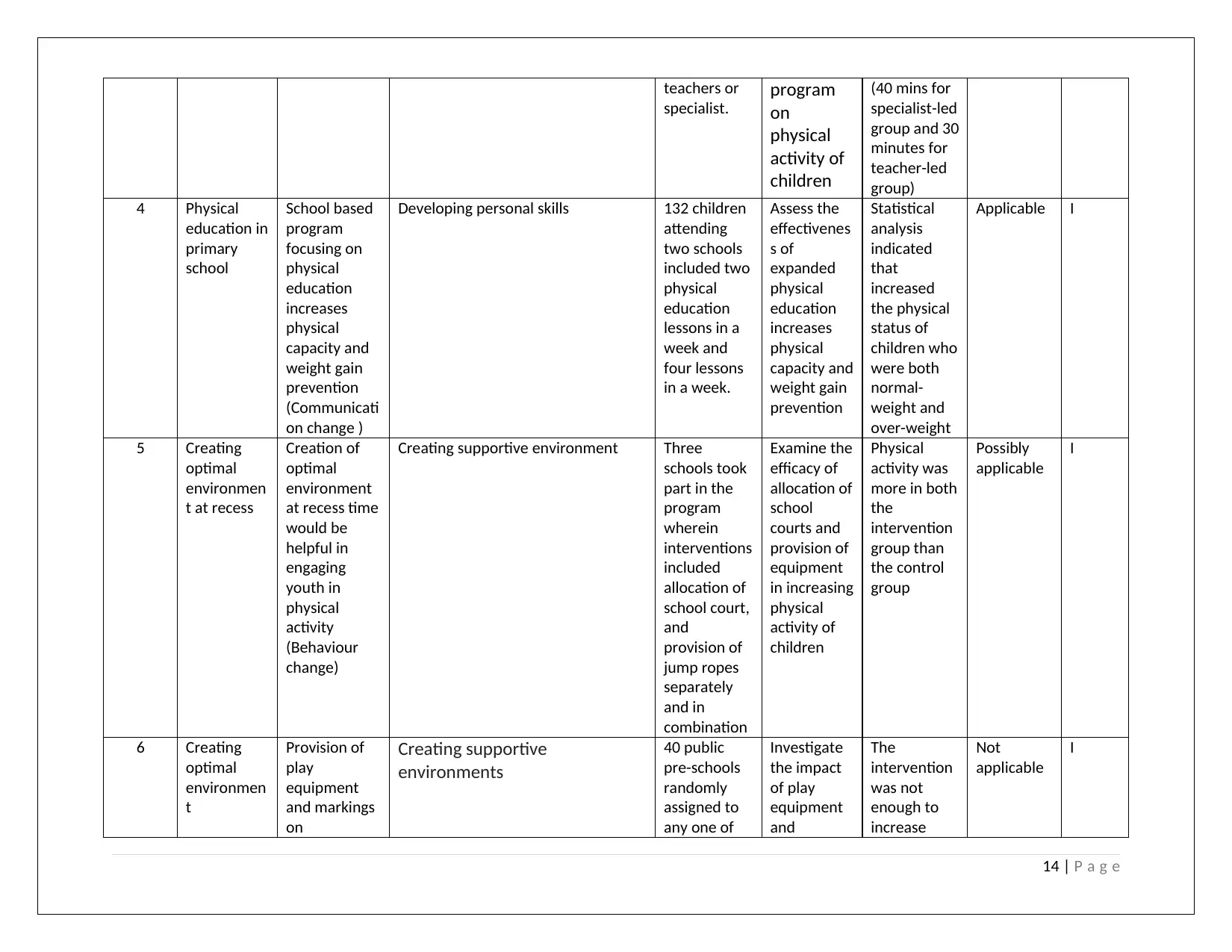
teachers or
specialist.
program
on
physical
activity of
children
(40 mins for
specialist-led
group and 30
minutes for
teacher-led
group)
4 Physical
education in
primary
school
School based
program
focusing on
physical
education
increases
physical
capacity and
weight gain
prevention
(Communicati
on change )
Developing personal skills 132 children
attending
two schools
included two
physical
education
lessons in a
week and
four lessons
in a week.
Assess the
effectivenes
s of
expanded
physical
education
increases
physical
capacity and
weight gain
prevention
Statistical
analysis
indicated
that
increased
the physical
status of
children who
were both
normal-
weight and
over-weight
Applicable I
5 Creating
optimal
environmen
t at recess
Creation of
optimal
environment
at recess time
would be
helpful in
engaging
youth in
physical
activity
(Behaviour
change)
Creating supportive environment Three
schools took
part in the
program
wherein
interventions
included
allocation of
school court,
and
provision of
jump ropes
separately
and in
combination
Examine the
efficacy of
allocation of
school
courts and
provision of
equipment
in increasing
physical
activity of
children
Physical
activity was
more in both
the
intervention
group than
the control
group
Possibly
applicable
I
6 Creating
optimal
environmen
t
Provision of
play
equipment
and markings
on
Creating supportive
environments
40 public
pre-schools
randomly
assigned to
any one of
Investigate
the impact
of play
equipment
and
The
intervention
was not
enough to
increase
Not
applicable
I
14 | P a g e
specialist.
program
on
physical
activity of
children
(40 mins for
specialist-led
group and 30
minutes for
teacher-led
group)
4 Physical
education in
primary
school
School based
program
focusing on
physical
education
increases
physical
capacity and
weight gain
prevention
(Communicati
on change )
Developing personal skills 132 children
attending
two schools
included two
physical
education
lessons in a
week and
four lessons
in a week.
Assess the
effectivenes
s of
expanded
physical
education
increases
physical
capacity and
weight gain
prevention
Statistical
analysis
indicated
that
increased
the physical
status of
children who
were both
normal-
weight and
over-weight
Applicable I
5 Creating
optimal
environmen
t at recess
Creation of
optimal
environment
at recess time
would be
helpful in
engaging
youth in
physical
activity
(Behaviour
change)
Creating supportive environment Three
schools took
part in the
program
wherein
interventions
included
allocation of
school court,
and
provision of
jump ropes
separately
and in
combination
Examine the
efficacy of
allocation of
school
courts and
provision of
equipment
in increasing
physical
activity of
children
Physical
activity was
more in both
the
intervention
group than
the control
group
Possibly
applicable
I
6 Creating
optimal
environmen
t
Provision of
play
equipment
and markings
on
Creating supportive
environments
40 public
pre-schools
randomly
assigned to
any one of
Investigate
the impact
of play
equipment
and
The
intervention
was not
enough to
increase
Not
applicable
I
14 | P a g e
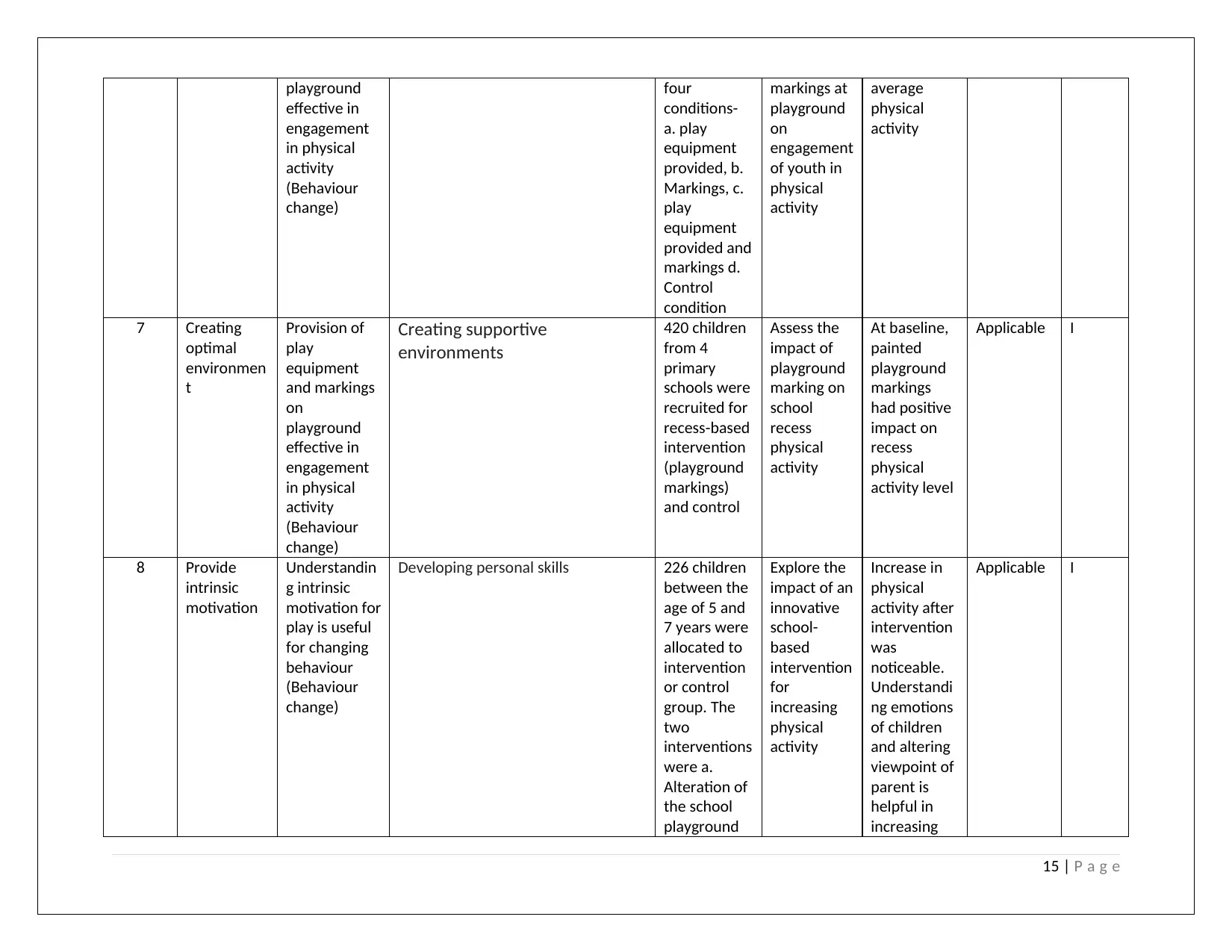
playground
effective in
engagement
in physical
activity
(Behaviour
change)
four
conditions-
a. play
equipment
provided, b.
Markings, c.
play
equipment
provided and
markings d.
Control
condition
markings at
playground
on
engagement
of youth in
physical
activity
average
physical
activity
7 Creating
optimal
environmen
t
Provision of
play
equipment
and markings
on
playground
effective in
engagement
in physical
activity
(Behaviour
change)
Creating supportive
environments
420 children
from 4
primary
schools were
recruited for
recess-based
intervention
(playground
markings)
and control
Assess the
impact of
playground
marking on
school
recess
physical
activity
At baseline,
painted
playground
markings
had positive
impact on
recess
physical
activity level
Applicable I
8 Provide
intrinsic
motivation
Understandin
g intrinsic
motivation for
play is useful
for changing
behaviour
(Behaviour
change)
Developing personal skills 226 children
between the
age of 5 and
7 years were
allocated to
intervention
or control
group. The
two
interventions
were a.
Alteration of
the school
playground
Explore the
impact of an
innovative
school-
based
intervention
for
increasing
physical
activity
Increase in
physical
activity after
intervention
was
noticeable.
Understandi
ng emotions
of children
and altering
viewpoint of
parent is
helpful in
increasing
Applicable I
15 | P a g e
effective in
engagement
in physical
activity
(Behaviour
change)
four
conditions-
a. play
equipment
provided, b.
Markings, c.
play
equipment
provided and
markings d.
Control
condition
markings at
playground
on
engagement
of youth in
physical
activity
average
physical
activity
7 Creating
optimal
environmen
t
Provision of
play
equipment
and markings
on
playground
effective in
engagement
in physical
activity
(Behaviour
change)
Creating supportive
environments
420 children
from 4
primary
schools were
recruited for
recess-based
intervention
(playground
markings)
and control
Assess the
impact of
playground
marking on
school
recess
physical
activity
At baseline,
painted
playground
markings
had positive
impact on
recess
physical
activity level
Applicable I
8 Provide
intrinsic
motivation
Understandin
g intrinsic
motivation for
play is useful
for changing
behaviour
(Behaviour
change)
Developing personal skills 226 children
between the
age of 5 and
7 years were
allocated to
intervention
or control
group. The
two
interventions
were a.
Alteration of
the school
playground
Explore the
impact of an
innovative
school-
based
intervention
for
increasing
physical
activity
Increase in
physical
activity after
intervention
was
noticeable.
Understandi
ng emotions
of children
and altering
viewpoint of
parent is
helpful in
increasing
Applicable I
15 | P a g e
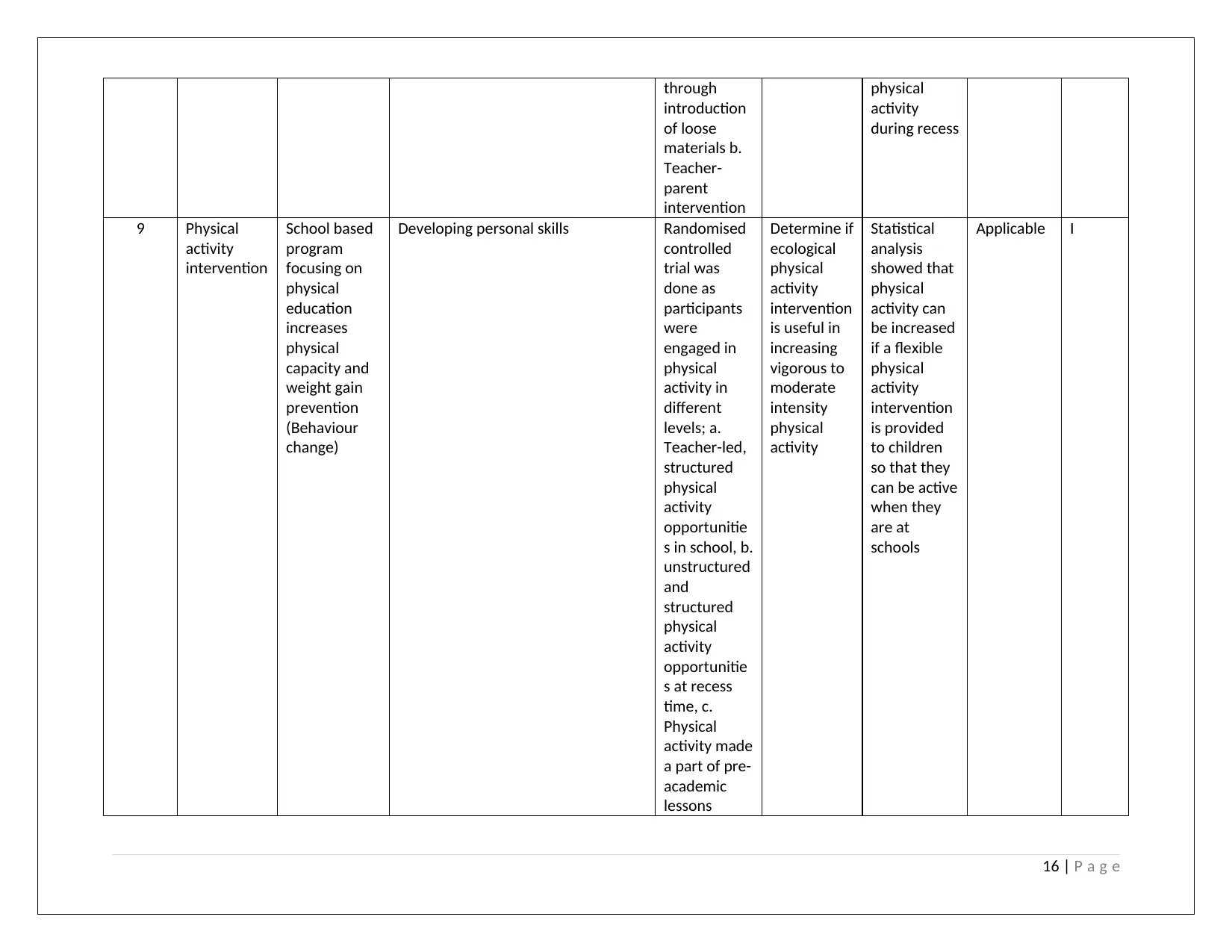
through
introduction
of loose
materials b.
Teacher-
parent
intervention
physical
activity
during recess
9 Physical
activity
intervention
School based
program
focusing on
physical
education
increases
physical
capacity and
weight gain
prevention
(Behaviour
change)
Developing personal skills Randomised
controlled
trial was
done as
participants
were
engaged in
physical
activity in
different
levels; a.
Teacher-led,
structured
physical
activity
opportunitie
s in school, b.
unstructured
and
structured
physical
activity
opportunitie
s at recess
time, c.
Physical
activity made
a part of pre-
academic
lessons
Determine if
ecological
physical
activity
intervention
is useful in
increasing
vigorous to
moderate
intensity
physical
activity
Statistical
analysis
showed that
physical
activity can
be increased
if a flexible
physical
activity
intervention
is provided
to children
so that they
can be active
when they
are at
schools
Applicable I
16 | P a g e
introduction
of loose
materials b.
Teacher-
parent
intervention
physical
activity
during recess
9 Physical
activity
intervention
School based
program
focusing on
physical
education
increases
physical
capacity and
weight gain
prevention
(Behaviour
change)
Developing personal skills Randomised
controlled
trial was
done as
participants
were
engaged in
physical
activity in
different
levels; a.
Teacher-led,
structured
physical
activity
opportunitie
s in school, b.
unstructured
and
structured
physical
activity
opportunitie
s at recess
time, c.
Physical
activity made
a part of pre-
academic
lessons
Determine if
ecological
physical
activity
intervention
is useful in
increasing
vigorous to
moderate
intensity
physical
activity
Statistical
analysis
showed that
physical
activity can
be increased
if a flexible
physical
activity
intervention
is provided
to children
so that they
can be active
when they
are at
schools
Applicable I
16 | P a g e
Secure Best Marks with AI Grader
Need help grading? Try our AI Grader for instant feedback on your assignments.
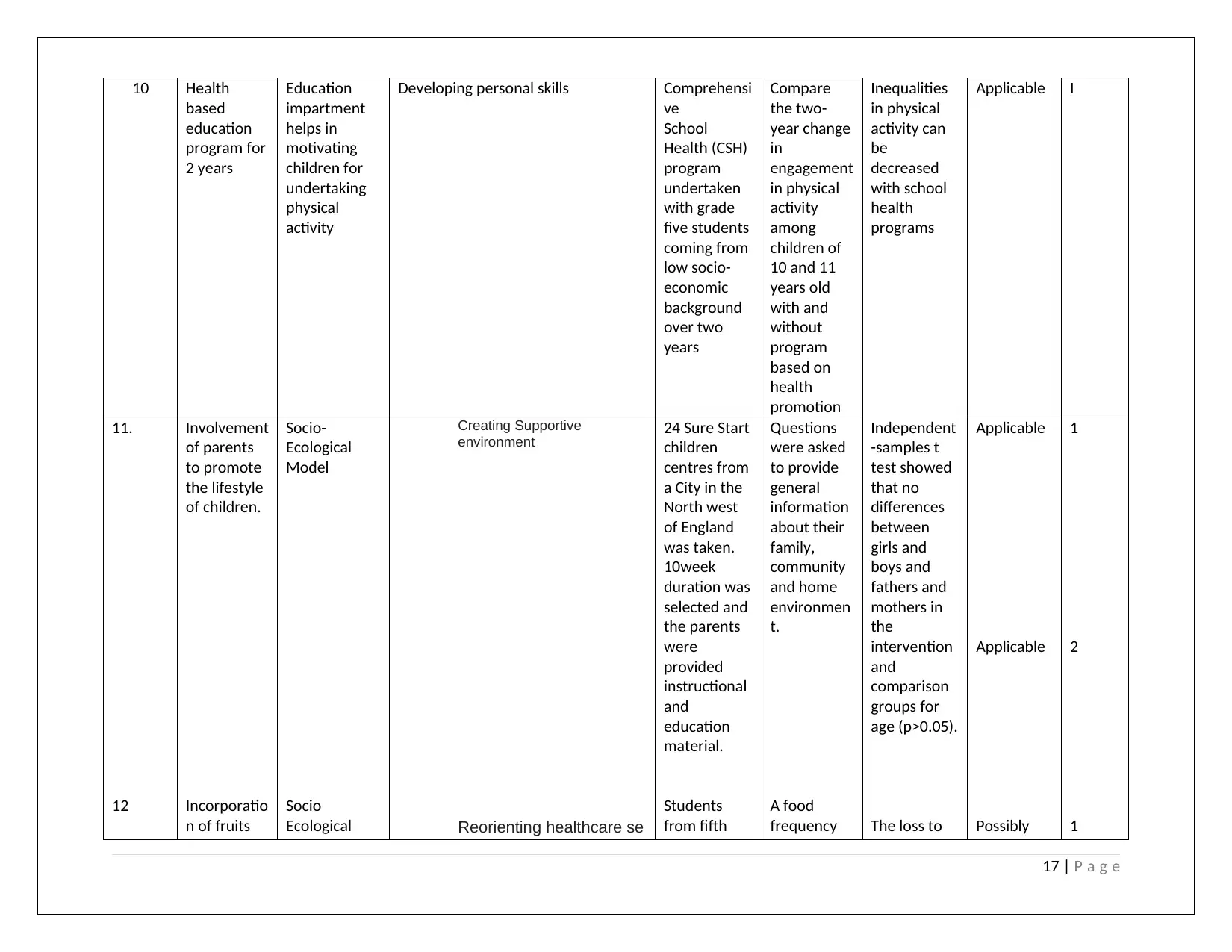
10 Health
based
education
program for
2 years
Education
impartment
helps in
motivating
children for
undertaking
physical
activity
Developing personal skills Comprehensi
ve
School
Health (CSH)
program
undertaken
with grade
five students
coming from
low socio-
economic
background
over two
years
Compare
the two-
year change
in
engagement
in physical
activity
among
children of
10 and 11
years old
with and
without
program
based on
health
promotion
Inequalities
in physical
activity can
be
decreased
with school
health
programs
Applicable I
11.
12
Involvement
of parents
to promote
the lifestyle
of children.
Incorporatio
n of fruits
Socio-
Ecological
Model
Socio
Ecological
Creating Supportive
environment
Reorienting healthcare se
24 Sure Start
children
centres from
a City in the
North west
of England
was taken.
10week
duration was
selected and
the parents
were
provided
instructional
and
education
material.
Students
from fifth
Questions
were asked
to provide
general
information
about their
family,
community
and home
environmen
t.
A food
frequency
Independent
-samples t
test showed
that no
differences
between
girls and
boys and
fathers and
mothers in
the
intervention
and
comparison
groups for
age (p>0.05).
The loss to
Applicable
Applicable
Possibly
1
2
1
17 | P a g e
based
education
program for
2 years
Education
impartment
helps in
motivating
children for
undertaking
physical
activity
Developing personal skills Comprehensi
ve
School
Health (CSH)
program
undertaken
with grade
five students
coming from
low socio-
economic
background
over two
years
Compare
the two-
year change
in
engagement
in physical
activity
among
children of
10 and 11
years old
with and
without
program
based on
health
promotion
Inequalities
in physical
activity can
be
decreased
with school
health
programs
Applicable I
11.
12
Involvement
of parents
to promote
the lifestyle
of children.
Incorporatio
n of fruits
Socio-
Ecological
Model
Socio
Ecological
Creating Supportive
environment
Reorienting healthcare se
24 Sure Start
children
centres from
a City in the
North west
of England
was taken.
10week
duration was
selected and
the parents
were
provided
instructional
and
education
material.
Students
from fifth
Questions
were asked
to provide
general
information
about their
family,
community
and home
environmen
t.
A food
frequency
Independent
-samples t
test showed
that no
differences
between
girls and
boys and
fathers and
mothers in
the
intervention
and
comparison
groups for
age (p>0.05).
The loss to
Applicable
Applicable
Possibly
1
2
1
17 | P a g e
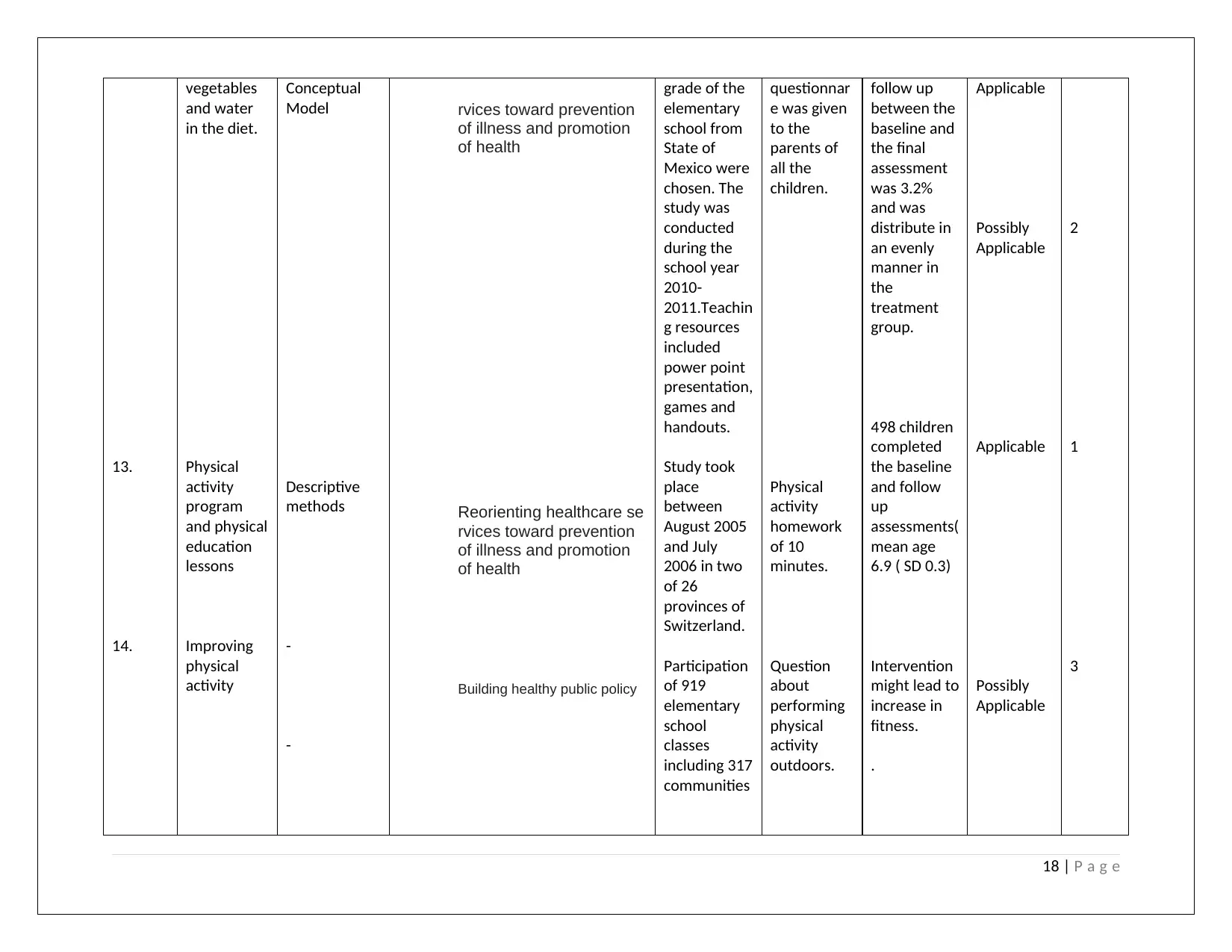
13.
14.
vegetables
and water
in the diet.
Physical
activity
program
and physical
education
lessons
Improving
physical
activity
Conceptual
Model
Descriptive
methods
-
-
rvices toward prevention
of illness and promotion
of health
Reorienting healthcare se
rvices toward prevention
of illness and promotion
of health
Building healthy public policy
grade of the
elementary
school from
State of
Mexico were
chosen. The
study was
conducted
during the
school year
2010-
2011.Teachin
g resources
included
power point
presentation,
games and
handouts.
Study took
place
between
August 2005
and July
2006 in two
of 26
provinces of
Switzerland.
Participation
of 919
elementary
school
classes
including 317
communities
questionnar
e was given
to the
parents of
all the
children.
Physical
activity
homework
of 10
minutes.
Question
about
performing
physical
activity
outdoors.
follow up
between the
baseline and
the final
assessment
was 3.2%
and was
distribute in
an evenly
manner in
the
treatment
group.
498 children
completed
the baseline
and follow
up
assessments(
mean age
6.9 ( SD 0.3)
Intervention
might lead to
increase in
fitness.
.
Applicable
Possibly
Applicable
Applicable
Possibly
Applicable
2
1
3
18 | P a g e
14.
vegetables
and water
in the diet.
Physical
activity
program
and physical
education
lessons
Improving
physical
activity
Conceptual
Model
Descriptive
methods
-
-
rvices toward prevention
of illness and promotion
of health
Reorienting healthcare se
rvices toward prevention
of illness and promotion
of health
Building healthy public policy
grade of the
elementary
school from
State of
Mexico were
chosen. The
study was
conducted
during the
school year
2010-
2011.Teachin
g resources
included
power point
presentation,
games and
handouts.
Study took
place
between
August 2005
and July
2006 in two
of 26
provinces of
Switzerland.
Participation
of 919
elementary
school
classes
including 317
communities
questionnar
e was given
to the
parents of
all the
children.
Physical
activity
homework
of 10
minutes.
Question
about
performing
physical
activity
outdoors.
follow up
between the
baseline and
the final
assessment
was 3.2%
and was
distribute in
an evenly
manner in
the
treatment
group.
498 children
completed
the baseline
and follow
up
assessments(
mean age
6.9 ( SD 0.3)
Intervention
might lead to
increase in
fitness.
.
Applicable
Possibly
Applicable
Applicable
Possibly
Applicable
2
1
3
18 | P a g e
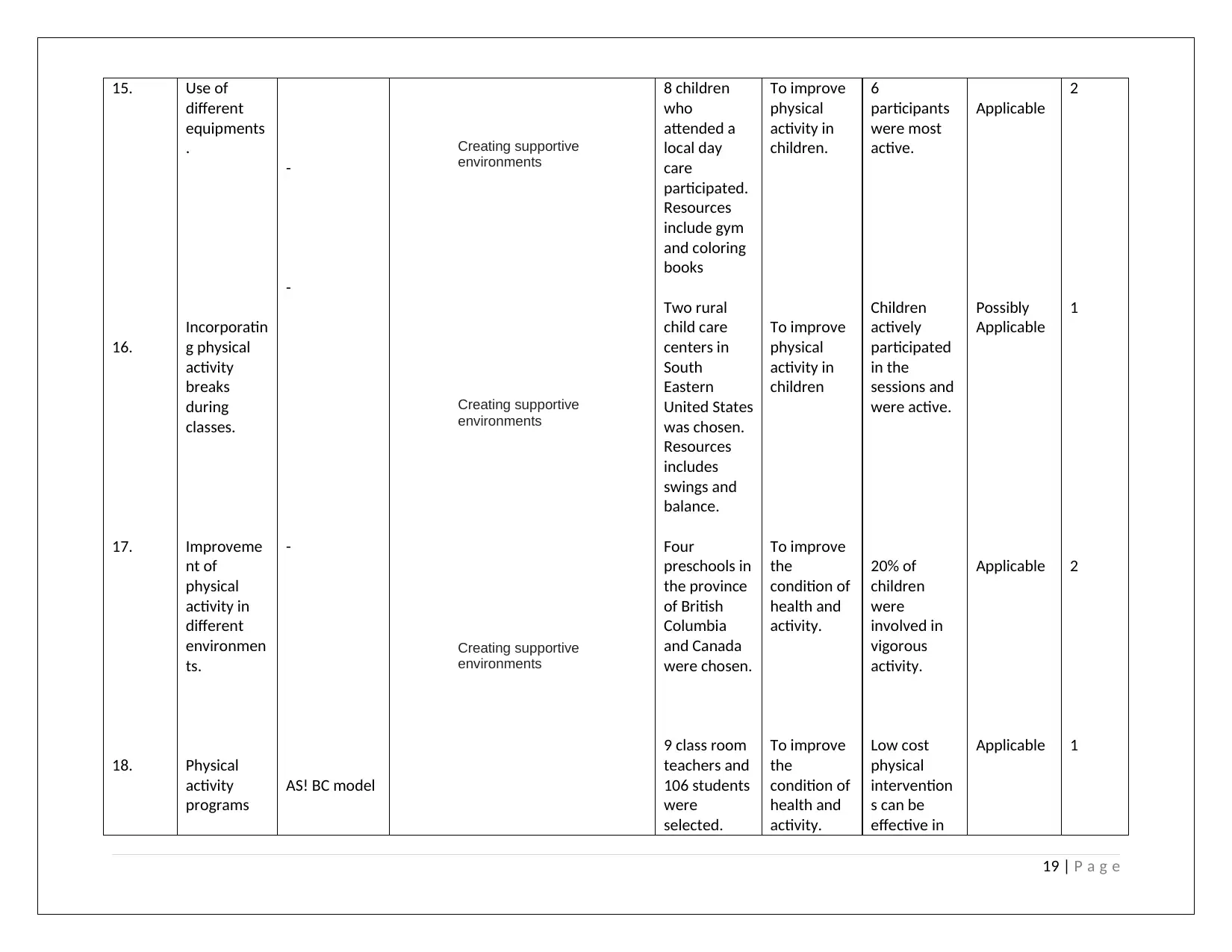
15.
16.
17.
18.
Use of
different
equipments
.
Incorporatin
g physical
activity
breaks
during
classes.
Improveme
nt of
physical
activity in
different
environmen
ts.
Physical
activity
programs
-
-
-
AS! BC model
Creating supportive
environments
Creating supportive
environments
Creating supportive
environments
8 children
who
attended a
local day
care
participated.
Resources
include gym
and coloring
books
Two rural
child care
centers in
South
Eastern
United States
was chosen.
Resources
includes
swings and
balance.
Four
preschools in
the province
of British
Columbia
and Canada
were chosen.
9 class room
teachers and
106 students
were
selected.
To improve
physical
activity in
children.
To improve
physical
activity in
children
To improve
the
condition of
health and
activity.
To improve
the
condition of
health and
activity.
6
participants
were most
active.
Children
actively
participated
in the
sessions and
were active.
20% of
children
were
involved in
vigorous
activity.
Low cost
physical
intervention
s can be
effective in
Applicable
Possibly
Applicable
Applicable
Applicable
2
1
2
1
19 | P a g e
16.
17.
18.
Use of
different
equipments
.
Incorporatin
g physical
activity
breaks
during
classes.
Improveme
nt of
physical
activity in
different
environmen
ts.
Physical
activity
programs
-
-
-
AS! BC model
Creating supportive
environments
Creating supportive
environments
Creating supportive
environments
8 children
who
attended a
local day
care
participated.
Resources
include gym
and coloring
books
Two rural
child care
centers in
South
Eastern
United States
was chosen.
Resources
includes
swings and
balance.
Four
preschools in
the province
of British
Columbia
and Canada
were chosen.
9 class room
teachers and
106 students
were
selected.
To improve
physical
activity in
children.
To improve
physical
activity in
children
To improve
the
condition of
health and
activity.
To improve
the
condition of
health and
activity.
6
participants
were most
active.
Children
actively
participated
in the
sessions and
were active.
20% of
children
were
involved in
vigorous
activity.
Low cost
physical
intervention
s can be
effective in
Applicable
Possibly
Applicable
Applicable
Applicable
2
1
2
1
19 | P a g e
Paraphrase This Document
Need a fresh take? Get an instant paraphrase of this document with our AI Paraphraser
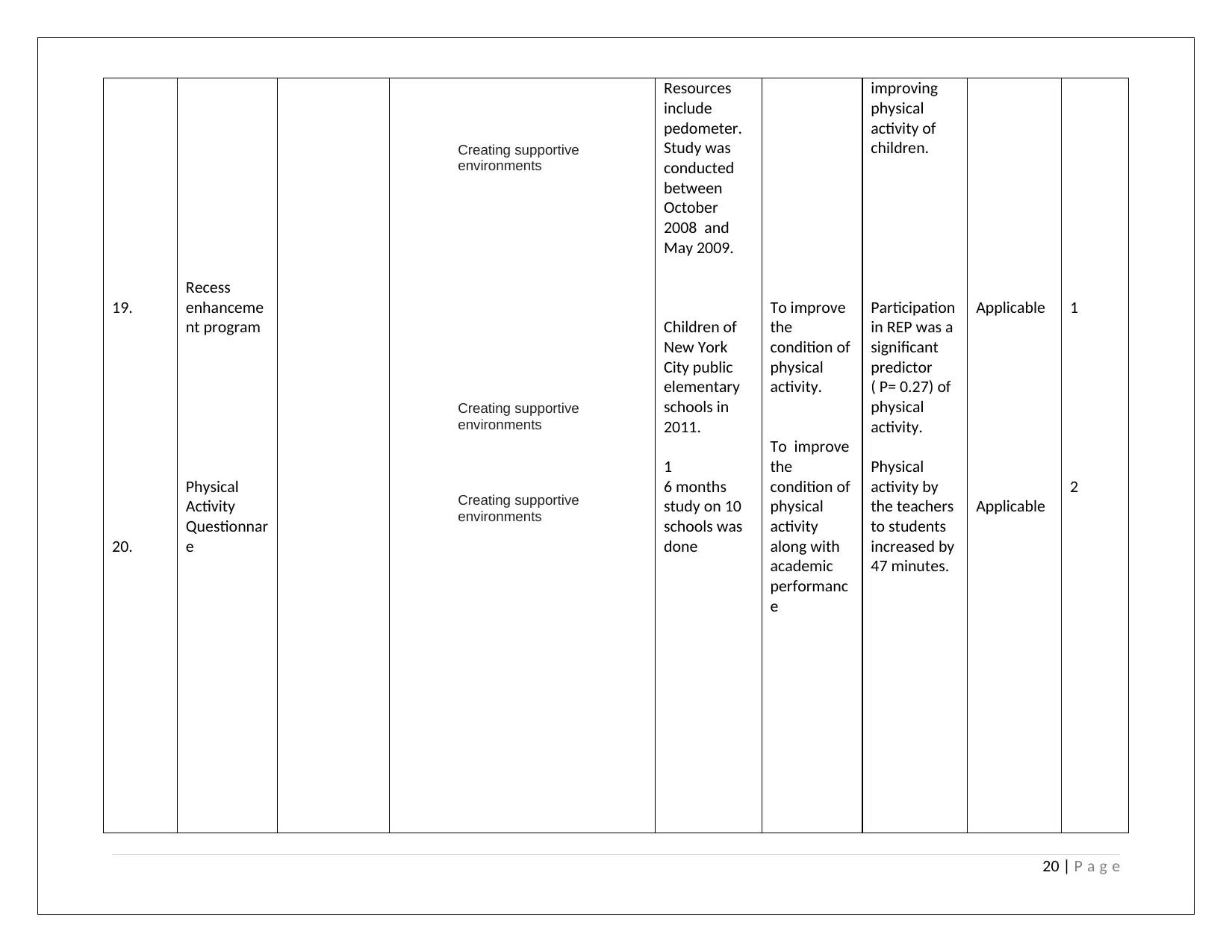
19.
20.
Recess
enhanceme
nt program
Physical
Activity
Questionnar
e
Creating supportive
environments
Creating supportive
environments
Creating supportive
environments
Resources
include
pedometer.
Study was
conducted
between
October
2008 and
May 2009.
Children of
New York
City public
elementary
schools in
2011.
1
6 months
study on 10
schools was
done
To improve
the
condition of
physical
activity.
To improve
the
condition of
physical
activity
along with
academic
performanc
e
improving
physical
activity of
children.
Participation
in REP was a
significant
predictor
( P= 0.27) of
physical
activity.
Physical
activity by
the teachers
to students
increased by
47 minutes.
Applicable
Applicable
1
2
20 | P a g e
20.
Recess
enhanceme
nt program
Physical
Activity
Questionnar
e
Creating supportive
environments
Creating supportive
environments
Creating supportive
environments
Resources
include
pedometer.
Study was
conducted
between
October
2008 and
May 2009.
Children of
New York
City public
elementary
schools in
2011.
1
6 months
study on 10
schools was
done
To improve
the
condition of
physical
activity.
To improve
the
condition of
physical
activity
along with
academic
performanc
e
improving
physical
activity of
children.
Participation
in REP was a
significant
predictor
( P= 0.27) of
physical
activity.
Physical
activity by
the teachers
to students
increased by
47 minutes.
Applicable
Applicable
1
2
20 | P a g e
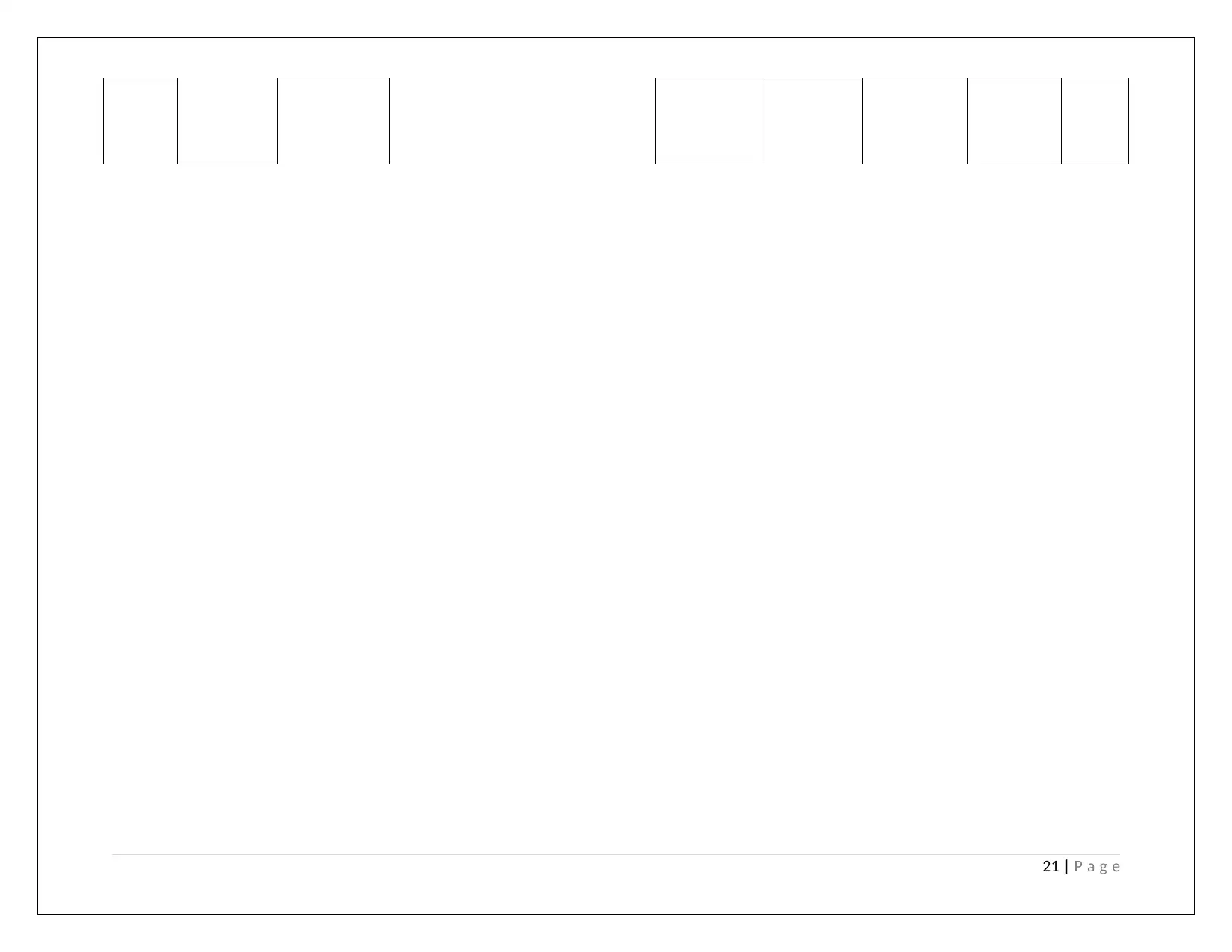
21 | P a g e
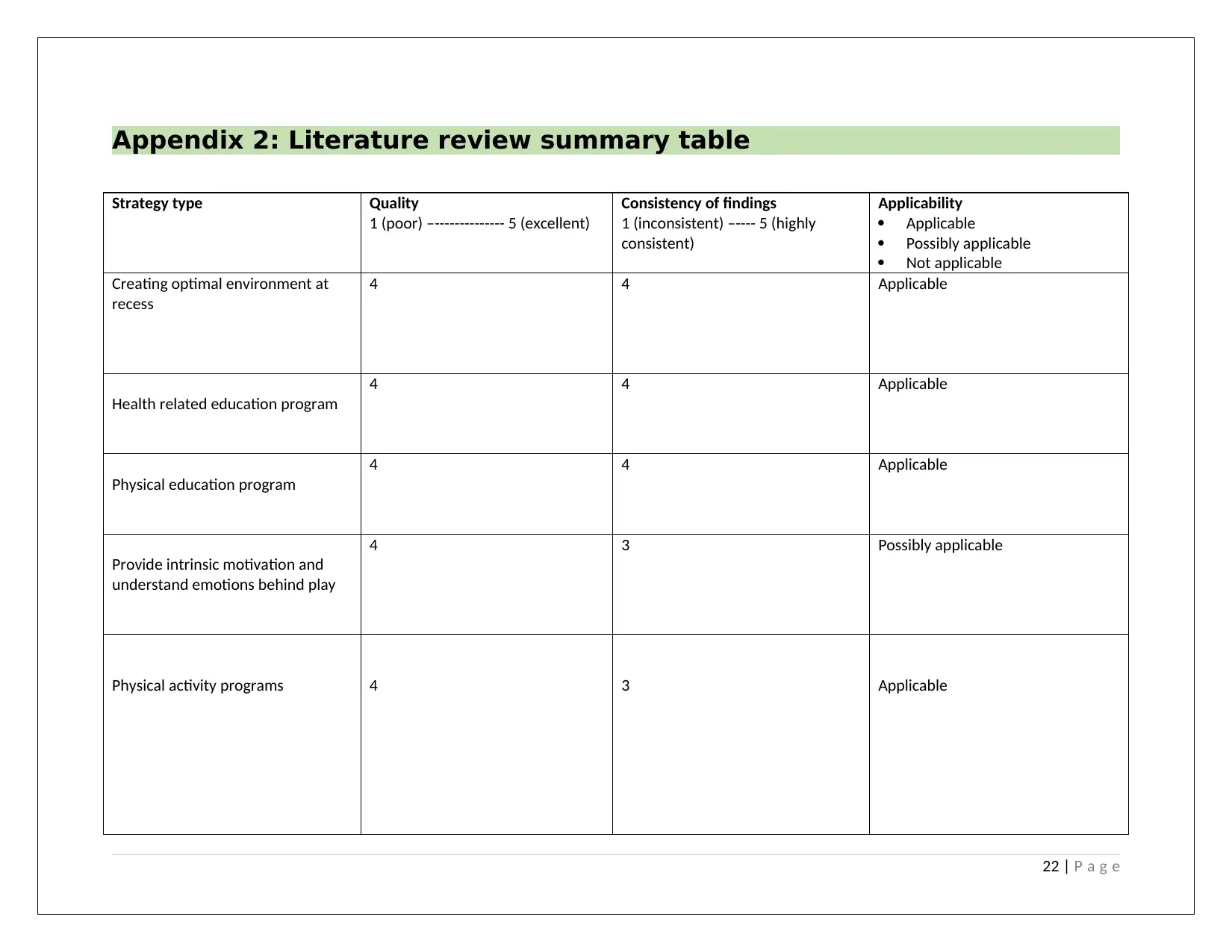
Appendix 2: Literature review summary table
Strategy type Quality
1 (poor) –-------------- 5 (excellent)
Consistency of findings
1 (inconsistent) –---- 5 (highly
consistent)
Applicability
Applicable
Possibly applicable
Not applicable
Creating optimal environment at
recess
4 4 Applicable
Health related education program
4 4 Applicable
Physical education program
4 4 Applicable
Provide intrinsic motivation and
understand emotions behind play
4 3 Possibly applicable
Physical activity programs 4 3 Applicable
22 | P a g e
Strategy type Quality
1 (poor) –-------------- 5 (excellent)
Consistency of findings
1 (inconsistent) –---- 5 (highly
consistent)
Applicability
Applicable
Possibly applicable
Not applicable
Creating optimal environment at
recess
4 4 Applicable
Health related education program
4 4 Applicable
Physical education program
4 4 Applicable
Provide intrinsic motivation and
understand emotions behind play
4 3 Possibly applicable
Physical activity programs 4 3 Applicable
22 | P a g e
Secure Best Marks with AI Grader
Need help grading? Try our AI Grader for instant feedback on your assignments.
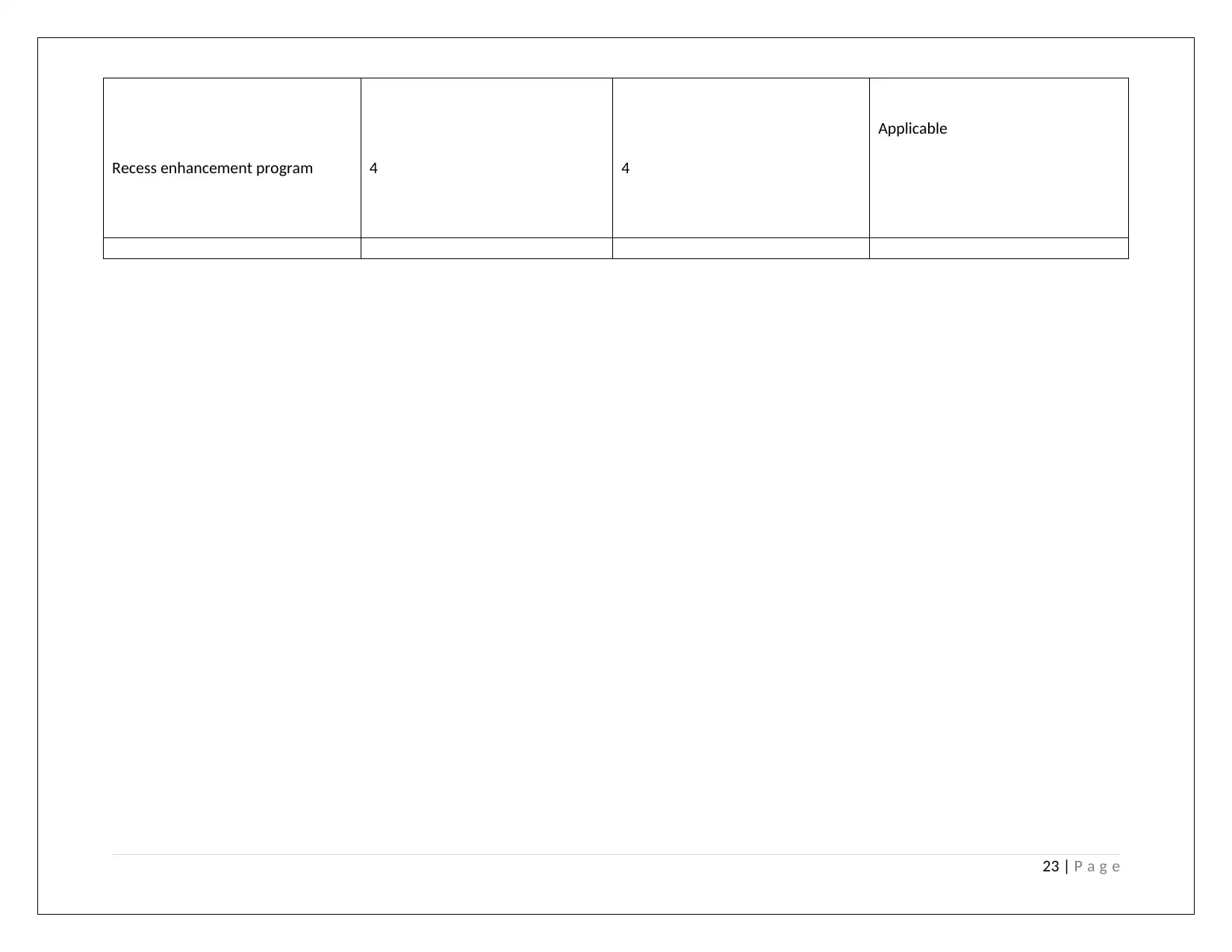
Recess enhancement program 4 4
Applicable
23 | P a g e
Applicable
23 | P a g e
1 out of 23
Related Documents
Your All-in-One AI-Powered Toolkit for Academic Success.
+13062052269
info@desklib.com
Available 24*7 on WhatsApp / Email
![[object Object]](/_next/static/media/star-bottom.7253800d.svg)
Unlock your academic potential
© 2024 | Zucol Services PVT LTD | All rights reserved.



